

Galactic barrier
- View history
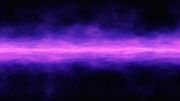
The galactic barrier
The galactic barrier was an energy field composed of negative energy surrounding the rim of the Milky Way Galaxy . Invisible to both the naked eye and visual recording equipment at a distance, at close range the barrier shone with a purple - to pink - colored glow. No form of transmission was known to be capable of penetrating the barrier. ( TOS : " By Any Other Name ") Warp travel through the barrier caused extreme sensory distortions. ( TOS : " Is There in Truth No Beauty? ") The barrier had been encountered on several occasions by Earth and Starfleet vessels . ( TOS : " Where No Man Has Gone Before ", " By Any Other Name ", " Is There in Truth No Beauty? ") The Stilph inhabited a region just inside the barrier. ( DIS : " All In ")
- 1.1 21st century
- 1.2 23rd century
- 1.3 32nd century
- 2.1 Appearances
- 2.2 Background information
- 2.3 Apocrypha
- 2.4 Related topics
- 2.5 External links
History [ ]
21st century [ ].
The first encounter involving an Earth vessel occurred in 2065 with the SS Valiant . The ship was swept into the barrier by a magnetic storm . Subsequent events resulted in the destruction of the Valiant and the loss of all hands, leaving the barrier's formal discovery to wait two hundred more years .
23rd century [ ]
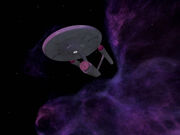
The USS Enterprise approaching the galactic barrier in 2265
In 2265 , the USS Enterprise under the command of Captain James T. Kirk discovered the disaster recorder ejected from the Valiant . Decoding its message, they retraced the Valiant 's path, being almost destroyed in the process. At that time the barrier did not register at all on the Enterprise 's sensors , although the ship's deflectors did react to it. ( TOS : " Where No Man Has Gone Before ")
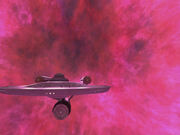
The Enterprise leaving the barrier
Entering the barrier is extremely hazardous. Shields could not block all the energies of the barrier; the leakage was sufficient to heat up the hull to over 2,000 degrees, ( TOS : " By Any Other Name ") damage several systems and disable the warp drive of the Enterprise . Also passing the shields and hull were strange electric shocks to the nervous systems of the Human crew members with high esper ratings . In most cases this caused death from brain damage, as was the case for nine Enterprise crewmembers . Individuals with the highest ESP ratings such as Dr. Elizabeth Dehner 's 089 and Lieutenant Commander Gary Mitchell 's 091 survived the shock and were altered as a result. They developed a multitude of psionic powers at a geometric rate. They began to view their former friends and shipmates as lower lifeforms . This transformation was known to have happened at least three times, with the best-known example being Mitchell. ( TOS : " Where No Man Has Gone Before ")
In 2268 , Kelvans from the Andromeda Galaxy entered the Milky Way Galaxy through the barrier. Their advanced multigenerational ships were damaged by the barrier and subsequently destroyed. The Kelvan survivors of one ship required a new vessel for the journey home. They hijacked the USS Enterprise and refitted it to survive the barrier and the intergalactic journey. Presumably, due to improvements in sensor technology, this time the Enterprise 's sensors registered the barrier as negative energy, but of such magnitude that all instruments were off the dials.
The option to flood the Enterprise 's warp nacelles with positive energy through control valves was available to Kirk, but not taken, during the passage through the barrier. Combination of that positive energy and the negative energy of the barrier would have destroyed the ship. ( TOS : " By Any Other Name ")
Later that year, the Enterprise left the Milky Way Galaxy when Larry Marvick , driven mad by the sight of Medusan Ambassador Kollos , sought to escape his tormenting visions. During that excursion the ship was stranded inside a space-time continuum void deep within the barrier. No sensor data or reference points were available to exit the void in the right direction. Fortunately, Kollos was able to help pilot the ship out. ( TOS : " Is There in Truth No Beauty? ")
32nd century [ ]
During the USS Discovery 's investigation of a subspace rift left by the Dark Matter Anomaly in 3190 , Cleveland Booker experienced an energy surge while unsuccessfully attempting to jump the ship via the spore drive . It was subsequently found that he had been exposed to particles unique to the galactic barrier, indicating that the DMA originated outside the galaxy. ( DIS : " Stormy Weather ")

The barrier in 3190
Later that same year, the decision was made to cross the galactic barrier to initiate first contact with the unknown Species 10-C after it was discovered that the DMA couldn't be destroyed. By this point, the energies within the galactic barrier had grown strong enough that shields were actually weakened by passing through, forcing the crew to find and hide in bubbles of stable space to enact repairs before continuing their travels. ( DIS : " The Galactic Barrier ")
Appendices [ ]
Appearances [ ].
- " Where No Man Has Gone Before "
- " By Any Other Name "
- " Is There in Truth No Beauty? "
- DIS : " The Galactic Barrier "
Background information [ ]
The script of "Where No Man Has Gone Before" likens the galactic barrier to the aurora borealis .
The composition of the barrier was somewhat controversial, based on the analyses during both encounters, as it was initially totally unknown. Negative (as in having no detectable) energy, radiation and density, TOS : " Where No Man Has Gone Before " but later on in TOS : " By Any Other Name " it is directly and clearly stated to be in fact negative energy ; not just negative (in) energy. This is evident from the plan to destroy the ship by venting positive energy inside the barrier to cause an explosion.
In Star Trek: Star Charts , on page 11, the barrier is depicted as a toroidal shape that surrounds the entire galactic disc. It's not situated at the rim as directly stated on screen in " By Any Other Name ", but only thickest at the rim; over 10,000 light years thick, starting out from a distance of 40,000 light years from the center of the galaxy, outward. Closer to the UFP's neighborhood of the galaxy, the barrier thins down to a thousand or so light years above and below. Even a large number of visible stars in the outer parts of the galactic disc are situated inside the barrier in the Star Trek: Star Charts cross-sectional view of the galaxy.
Furthermore, the Valiant , the Enterprise , the Kelvans etc. didn't exit, enter or try to exit the galaxy throughout the rim, but from the closer and thinner above and below parts of the barrier. Visual evidence presented in the episodes would however contradict this notion. Star Trek: Star Charts also states that the neurogenic effects of the barrier are unpredictable. The energy field of the barrier joins up with the Great Barrier at the center of the galaxy. It is stated to be a distinct but related energy field. Star Trek: Star Charts would however seem to contradict itself on page 13, as the USS Voyager is stated to have started its journey home from a distance of approximately 50,000 light years from the galactic center. This would have placed it well within the barrier based on the earlier depiction on page 11.
A further contradiction occurs in PIC : " The Star Gazer " which mentions a Starfleet vessel, the USS Leondegrance , travelling to the Lesser Magellanic Cloud for a five-year mission of exploration. Assuming this refers to the galaxy also known as the Small Magellanic Cloud, that would mean the Leondegrance left the Milky Way, with no reference to it encountering the barrier. The extragalactic nature of the Leondegrance' s mission is somewhat called into question by DIS : " The Galactic Barrier ", when Admiral Vance says that "( Discovery is) going outside the galaxy. We've never done that." This indicates that as of 3190 , Starfleet had not sent any official missions beyond the Milky Way.
Apocrypha [ ]
Greg Cox 's Star Trek: The Next Generation - Q Continuum novels state that the galactic barrier was in fact created by the Q Continuum 500,000 years ago as a method of preventing the powerful being known only as " 0 " from returning to the Milky Way Galaxy, from which he was banished for his destruction of the Tkon Empire . Even in 2374 , the galactic barrier is still extremely dangerous for starships to travel through. These novels also explain that the telepathic powers that occur as a side effect of exposure to the barrier in telepaths are caused by the power of the Q that exist in the barrier, while those who develop a god complex are 'infected' by the presence of 0, who constantly attempts to affect beings on the other side to give himself access to the galaxy once again. During an attack by the Calamarain , the USS Enterprise -E was forced to hide in the barrier, but Lieutenant Reginald Barclay managed to come up with the idea of using the bio-neural gel packs to absorb the psychic energy from the barrier to enhance their shields, providing some improved protection from the barrier's psychic influence. As the Enterprise departed the barrier, Betazoid scientist Lem Faal managed to briefly open an artificial wormhole leading to the other side. However, as this resulted in 0 briefly returning to our galaxy and only being defeated by the alliance of Q and the Calamarain, it is unlikely that the Federation will ever use this technology to begin exploration in other galaxies.
In Q-Squared , a disembodied Q is the one who takes over Dr. Elizabeth Dehner and Lieutenant Commander Gary Mitchell.
In the novel The Wounded Sky the galactic barrier was a temporary phenomenon that no longer existed in 2275 . It was the leading wavefront of a "megabubble" that was created by an exploding "metastar" in one of the Milky Way Galaxy's satellite globular clusters.
In the Star Trek: Stargazer series of books, the barrier can be easily traveled through in 2333 due to improvements in shield technology. There are a number of star systems outside the barrier, including one populated by the descendants of the SS Valiant crew, who all have minor telepathic and telekinetic abilities. In the novel Maker , a member of the Nuyyad race goes on a rampage after becoming god-like in power from exposure to the barrier. He is eventually killed; however, he continues to exist as an energy lifeform and returns to the barrier.
In the novel Captain's Glory , it is theorized that the barrier was created by the first humanoid race 4 billion years ago to protect the Milky Way Galaxy from the Totality, a dark matter-based lifeform.
According to the game Star Trek: Starfleet Academy , the library computer entry on the planet killer mentions a school of thought which believes that the galactic energy barrier may have been created by some ancient race as a safeguard in order to keep things such as the planet killers out of the galaxy. The entry also states that if this is true, then the barrier is not very effective.
According to the novel The Higher Frontier , Humans are not a naturally psychic race, as they lack a paracortex or similar structure in their brains. Instead, every Human esper is bonded with a Spectre, a non-corporeal entity that provides its host with psychic ability. The galactic barrier awakened and supercharged Mitchell and Dehner's Spectres, driving them insane in the process. The galactic barrier apparently has no effect on naturally telepathic species, which explains why Spock wasn't affected.
In the comic Blood Fever , the Romulans established a secret base near the galactic barrier in 2280 in order to study its effects. They learned that the barrier's power allowed it to give psychic abilities to Humanoids . Romulan Star Empire scientists eventually discovered a means of leeching the barrier of its power and bestowing it on their test subjects. Their base of operations and their experiment was found out about by Vulcan spy Xon whose true nature was discovered which resulted in his capture. The Enterprise was involved in a rescue attempt and during the skirmish, the Romulan ship was lost in the barrier where its scientific discovery was lost to the Empire.°
Related topics [ ]
- Beyond the Galactic Edge, Humanity's Quest for Infinity
External links [ ]
- ONE TREK MIND: The Galactic Barrier at StarTrek.com
- Strange New Worlds #3: The Galactic Barrier at StarTrek.com
- Galactic barrier at Memory Beta , the wiki for licensed Star Trek works
- 3 ISS Enterprise (NCC-1701)
- Cast & crew
- User reviews
The Galactic Barrier
- Episode aired Feb 24, 2022

Captain Burnham and her crew must go where few have gone before: beyond the Galactic Barrier. Meanwhile, Book learns the truth of what drives Ruon Tarka. Captain Burnham and her crew must go where few have gone before: beyond the Galactic Barrier. Meanwhile, Book learns the truth of what drives Ruon Tarka. Captain Burnham and her crew must go where few have gone before: beyond the Galactic Barrier. Meanwhile, Book learns the truth of what drives Ruon Tarka.
- Deborah Kampmeier
- Gene Roddenberry
- Bryan Fuller
- Alex Kurtzman
- Sonequa Martin-Green
- Anthony Rapp
- 39 User reviews
- 5 Critic reviews

- Michael Burnham

- Lt. Cmdr. Paul Stamets

- Dr. Hugh Culber

- Cleveland Booker

- Admiral Charles Vance

- Federation President Laira Rillak

- President T'Rina

- Capt. Ndoye

- Lt. Cmdr. Keyla Detmer

- Lt. Cmdr. Gen Rhys

- Lt. Cmdr. Joann Owosekun
- All cast & crew
- Production, box office & more at IMDbPro
Did you know
- Trivia Kovich says Discovery is heading to the galactic barrier for a "three hour tour", and tells Saru it is an Earth figure of speech. It is a reference to Gilligan's Island (1964) , where the the passengers of a boat on a three hour tour are stranded on an island for years.
- Connections References Gilligan's Island (1964)
User reviews 39
- pjdickinson-27822
- Feb 24, 2022
- February 24, 2022 (United States)
- United States
- Official Site
- Pinewood Toronto Studios, Port Lands, Toronto, Ontario, Canada (Studio)
- See more company credits at IMDbPro
Technical specs
- Runtime 52 minutes
Related news
Contribute to this page.

- See more gaps
- Learn more about contributing
More to explore

Recently viewed
Star Trek: What Is The Galactic Barrier?
What secrets does Star Trek's galactic barrier hold? A mystery guarding the Milky Way, its origins and purpose remain shrouded in intrigue.
In Star Trek , there exists a formidable force known as the galactic barrier, which surrounds the outer reaches of the Milky Way Galaxy. This phenomenon was first revealed in the second pilot episode of The Original Series, titled "Where No Man Has Gone Before." It defies both technological sensors and the human eye, but upon closer approach, it emanates a captivating surge of negative energy.
Fueled by unyielding curiosity, the valiant crew of the USS Enterprise, led by the intrepid Captain James T. Kirk, confronts their most daunting ordeal. Driven by a thirst for knowledge and hunger for exploration, they traverse the threshold and plunge fearlessly into the unknown. While rarely witnessed or acknowledged throughout the Star Trek narrative, the galactic barrier stands as an indelible cornerstone of the Trek canon.
RELATED: Star Trek’s Original Series Shows That Science Fiction Has Always Been Political
Location Of The Galactic Barrier
The galactic barrier is at the rim of the Milky Way Galaxy, forming an energy field around the galaxy's edge. It guards the uncharted territories that lie beyond. Although its exact location within the galaxy remains somewhat ambiguous, it serves as a threshold separating the familiar realms of known space from the unexplored.
In terms of appearance, the galactic barrier cannot be seen through ordinary perception. Advanced sensors and the naked eye are incapable of perceiving its true nature. However, for those daring enough to venture closer, the barrier reveals itself in a mesmerizing display. Emitting a distinctive wave of negative energy, it bathes the immediate vicinity in color. The barrier's radiance transitions from a commanding shade of purple to a softer, more delicate pink. This captivating phenomenon serves as a testament to the unseen forces guarding the uncharted frontiers of the Milky Way . In Where No Man Has Gone Before," the galactic barrier is likened to the aurora borealis. The true essence of the barrier remains elusive, inviting debates and controversies regarding its composition.
However, as The Original Series progressed, revelations emerged. In the episode "By Any Other Name," the ambiguity was dispelled. The characters and the viewers learned that the barrier was composed of negative energy. This clarified that the barrier encompassed not merely the absence of energy, but rather a distinct form of energy resolute in its negativity.
This vital revelation became apparent through the destruction of the USS Enterprise . By venting positive energy into the barrier, an explosive reaction was triggered. This desperate strategy exposed the barrier's vulnerability to opposing forces, reinforcing the notion that it thrived with negative energy, drawing strength from its antithesis.
The Purpose Of The Galactic Barrier
In the expanded universe of Star Trek novels (specifically, The Next Generation - Q Continuum novel series), an intriguing explanation emerges regarding the galactic barrier. According to this storyline, the barrier was not a natural occurrence but rather a deliberate creation by the omnipotent beings known as the Q Continuum . These entities possessed immense power and knowledge, and purportedly fashioned the barrier half a million years ago with a specific purpose: to impede the return of a powerful and mysterious entity referred to as "0."
In this lore, "0" is an enigmatic being whose nature and intentions are shrouded in uncertainty. Recognizing the immense threat that "0" posed, the Q Continuum devised the galactic barrier to prevent its reentry into the Milky Way Galaxy. It stands as a cosmic wall, designed to obstruct and bar the path of this powerful entity, ensuring its isolation beyond the confines of the galaxy.
This revelation adds another layer of intrigue to the nature of the galactic barrier, intertwining it with the machinations of the Q Continuum. It hints at a grand cosmic chessboard where powerful entities maneuver and manipulate the fabric of reality to safeguard against existential threats. However, it is essential to note that the information regarding the galactic barrier's origin as depicted in The Q Continuum novels exists in the realm of non-canonical expanded materials . Though it offers an intriguing perspective, it falls outside the officially recognized Star Trek canon. Its inclusion within the broader Star Trek lore remains a matter of personal interpretation and preference.
Historical Encounters With The Galactic Barrier
In Star Trek canon, the first encounter involving a vessel from Earth occurred in the year 2065, featuring the ill-fated SS Valiant. Trapped in a magnetic storm, the ship found itself ensnared within the alluring grasp of the barrier. Subsequent events unfolded in a disastrous manner, leading to the Valiant's demise and the loss of all crew members. As a result, the revelation of the barrier's existence had to wait for an additional two centuries.
Fast-forward to the year 2265. The USS Enterprise, under the command of the resolute Captain Kirk , stumbled upon a remarkable artifact: the disaster recorder expelled from the ill-fated Valiant. Embarking on a mission to decipher its encoded message, the crew retraced the Valiant's trajectory, risking destruction themselves. The barrier's presence eluded the sensors of the Enterprise, concealing its ethereal essence. However, the ship's resolute deflectors reacted to it, a testament to the power emanating from the boundary.
Captain Kirk ventured through the galactic barrier three times in The Original Series surviving despite the damage inflicted upon the starship and its shields. These encounters showcased his unwavering determination and the resilience of his crew. Their triumph over adversity left an indelible mark on Star Trek lore, symbolizing humanity's unyielding pursuit of exploration.
MORE: Star Trek: Kirk's Biggest Mistakes & Failures
Memory Beta, non-canon Star Trek Wiki
A friendly reminder regarding spoilers ! At present the expanded Trek universe is in a period of major upheaval with the continuations of Discovery and Prodigy , the advent of new eras in gaming with the Star Trek Adventures RPG , Star Trek: Infinite and Star Trek Online , as well as other post-57th Anniversary publications such as the ongoing IDW Star Trek comic and spin-off Star Trek: Defiant . Therefore, please be courteous to other users who may not be aware of current developments by using the {{ spoiler }}, {{ spoilers }} OR {{ majorspoiler }} tags when adding new information from sources less than six months old (even if it is minor info). Also, please do not include details in the summary bar when editing pages and do not anticipate making additions relating to sources not yet in release. THANK YOU
- Memory Beta articles sourced from short stories
- Stellar cartography
Galactic barrier
- View history

The galactic barrier in 2265 .

The USS Enterprise departs the barrier.
The galactic barrier is an energy field that surrounds the Milky Way Galaxy , delineating the border between the galactic material and the intergalactic void . The barrier appears as a purple/pink band of energy , and has been encountered several times by Earth and Starfleet vessels.
- 1.1 By the Progenitors
- 1.2 Q Continuum
- 1.3 By the Preservers
- 3 External links
Creation [ ]
By the progenitors [ ].
By one account, the Galactic Barrier was an artificial construct and dated its creation at around four billion years ago. It was speculated that the Galactic barrier was created by the Progenitors when they came under assault by the Totality . This led to the ancient race's downfall, but protected the younger Humanoid species that they had seeded on thousands of worlds. ( TOS novel : Captain's Glory )
Q Continuum [ ]
The barrier was specifically polarized over 500,000 years ago by the Q Continuum as a means of containing 0 in the void between the Milky Way Galaxy and the Andromeda Galaxy , thus protecting the Milky Way from his evil influence. ( TNG novel : Q-Strike )
The barrier did receive a significant influx of psionic energy during a dispute between Q and Trelane . ( TNG novel : Q-Squared )
By the Preservers [ ]
Circa 2269 , interfacing with a Preserver obelisk showed Spock an account stating that the Preservers had created the barrier, it being powered by the various Preserver outposts throughout the Milky Way. By this time, the strength of the barrier had begun to wane, as it had only ever been intended to safeguard the new generation of species until they became strong enough to defend themselves. ( TOS - Year Four comic : " The Enterprise Experiment, Part 5 ")
History [ ]
In December 2069 , the Earth vessel SS Valiant was swept into the barrier after encountering a magnetic storm . Contact with the barrier left six crewmembers dead and chief engineer Geirrod Agnarsson was transformed into a psionic super- human after a disorientated Q possessed him. After Agnarsson killed several security guards, Captain Carlos Tarasco had no choice but to order the destruction of his own ship, after all crew had left via escape pods . Unfortunately, only 12 crew managed to survive the explosion and they soon began to develop psionic abilities due to their close proximity to the barrier. ( TNG novels : The Valiant , Q-Squared ; TOS episode : " Where No Man Has Gone Before ")
In 2265 , Admiral Saylor of Starbase 33 ordered the USS Enterprise to explore the edge of the galaxy, and even probe beyond the barrier. However, upon the Enterprise' s arrival at the barrier, nine crewmembers were killed and two others began to change into super-human beings, as Q once again tried to reach out to their minds. ( TOS episode : " Where No Man Has Gone Before " and TNG novel : Q-Squared )
When a party of Kelvans took control of the Enterprise in 2268 in order to begin the journey back to Kelva , they forced the Enterprise crew to take the ship out of the galaxy. The Enterprise was able to successfully cross the barrier this time, thanks to modifications the Kelvans forced the Enterprise crew to make. ( TOS episode : " By Any Other Name ")
In 2280 , the Romulans established a secret base near the Galactic Barrier in order to study its effects. They had learnt that the barrier's power allowed it to give psychic abilities on humanoids. Romulan Star Empire scientists eventually discovered a means of leeching the barrier of its power and bestowing it on their test subjects. Their base of operations and their experiment was found out about by Vulcan spy Xon whose true nature was discovered which resulted in his capture. The USS Enterprise was involved in a rescue attempt and during the skirmish, the Romulan ship was lost in the barrier where its scientific discovery was lost to the Empire. ( TOS comic : " Blood Fever ")
Sometime after the Borg had attacked El-Auria , Delcara acquired a small one-person ship and used it to cross the barrier. Delcara managed to locate the Planet Killer that had been left by the Preservers after their war with the Borg . By the mid- 24th century technology had improved to the point that ships stood a much better chance of surviving an encounter with the barrier, but even then there was little interest in exploring space beyond the barrier as it would take centuries to cross the void between the Milky Way and Andromeda galaxies. ( TNG novel : Vendetta )
Following a battle with Trelane in 2370 , Q was sent back to the initial creation of the barrier, and was turned into a non-corporeal entity by Trelane. Being in a deeply disorientated state, Q became trapped inside the barrier until the 23rd century . ( TNG novel : Q-Squared )
In 2379 , following the energies of the Orb of Creation and the Orb of Destruction colliding on Qo'noS on the "Day of Blood", Ensign T'Lir requested that Starfleet Science monitor the galactic barrier to see if the Orbs' energy had affected it. ( ST - Star Trek (IDW 2022) comic : " Issue 12 ")
In 2381 , the Caeliar tanwa-seynorral Ordemo Nordal told Troi that they chose the Milky Way for their research as it had sheltering effects no other Galaxy possessed. When asked to elaborate, he referenced the galactic barrier that surrounded the Milky Way, cryptically stating that beyond the galaxy, "there are many powers of varying degrees of malevolence. The only sanctuary we've found from their malicious interferences has been here, within the protective embrace of the galactic barrier." ( ST - Destiny novel : Mere Mortals )
The barrier still existed in 2568 , as Prefect Tamar 's ship was badly damaged while crossing it. ( TOS - Strange New Worlds 9 short story : " Gone Native ")
In 3190 , the USS Discovery crossed through the barrier in its journey to make first contact with the extragalactic Species 10-C . ( DSC episode : " The Galactic Barrier ")
External links [ ]
- Galactic barrier article at Memory Alpha , the wiki for canon Star Trek .
- 1 Ferengi Rules of Acquisition
- 2 The Chase
- 3 ISS Enterprise (NCC-1701)

- April 28, 2024 | Interview: ‘Star Trek: Discovery’ Writer Carlos Cisco On Unmasking The Breen And Revisiting The ISS Enterprise
- April 26, 2024 | Michael Dorn Wanted Armin Shimerman To Play The Ferengi That Worf Killed In Star Trek Picard
- April 26, 2024 | Podcast: All Access Gets To Know The Breen In ‘Star Trek: Discovery’ 505, “Mirrors”
- April 25, 2024 | Prep Begins For ‘Star Trek: Strange New Worlds’ Season 3 Finale; Cast And Directors Share BTS Images
- April 25, 2024 | Jonathan Frakes Sees Opportunities With Streaming Star Trek Movies, Weighs In On “Filler Episodes”
Review: ‘Star Trek: Discovery’ Faces The Frontier In “The Galactic Barrier”
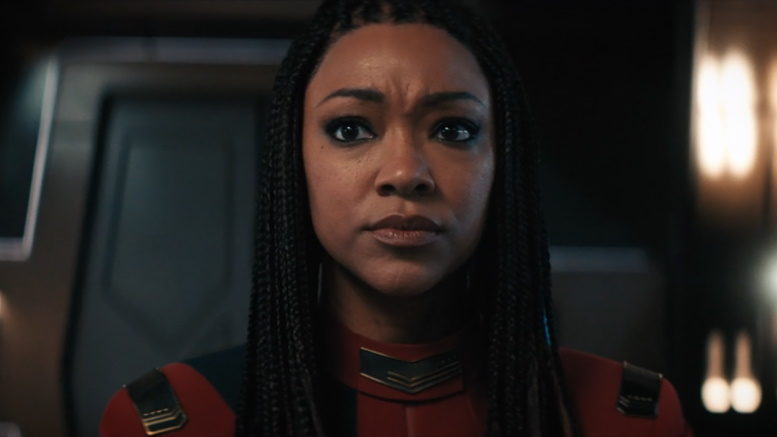
| February 24, 2022 | By: Anthony Pascale 136 comments so far
“The Galactic Barrier”
Star Trek: Discovery Season 4, Episode 10 – Debuted Thursday, February 24, 2022 Written by Anne Cofell Saunders Directed by Deborah Kampmeier
SPOILER-FREE REVIEW
With a lot of flash and filler, “The Galactic Barrier” is more of a setup for what comes next than a fulfilling standalone episode. Ostensibly focused on galactic sci-fi action, the episode’s true strength turned out to be a more personal exploration of some of the lingering character arcs of the season.
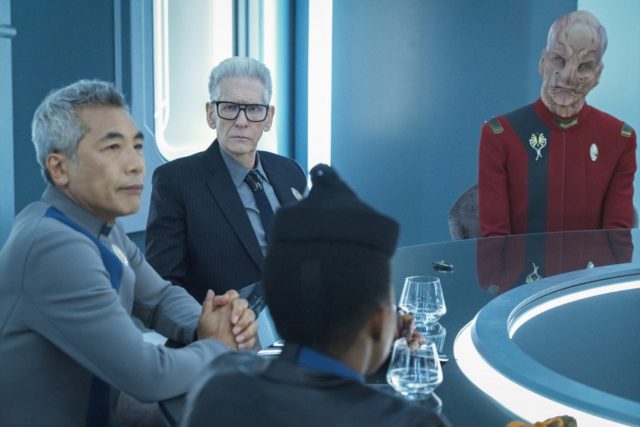
WARNING: Spoilers below!
“Frontiers are always cool”
Book and Tarka blowing up the DMA has rushed the first contact mission, so Dr. Kovich brings some universal translator props along to a bigwig meeting to make the point they don’t even know where to start when it comes to communicating with Species 10-C. He wishes the mission luck as he is going to stay behind to remain mysterious, introducing quirky communication specialist Dr. Hirai to go in his stead. The new DMA is more DMA-y than the last, giving them just 12 hours before it moves on. President Rillak volunteers herself for the mission, deciding her authority and skills are needed, with an ominously touching goodbye with Admiral Vance. Gulp. Suru has an equally ominous goodbye with Bryce. Double gulp. With the Disco loaded up and upgraded with Galactic Barrier shielding, Captain Burnham and the Prez negotiate divided responsibilities with Michael handling the ship and Rillak in charge of diplomacy.
With a nice little speech complete with some classic callbacks and her new catchphrase, off they go to the actual final frontier, finding the barrier in its roiling awesome and terrifying beauty. The new programmable antimatter shielding will prevent everyone from going all silver-eyed crazy , but they find getting through harder than expected. Thankfully, Stamets has a brand-new plan for the ship to ride through, protected inside a giant technobabble space bubble, requiring this finely tuned crew to work together in an impressive bridge ballet. While they await the crossing, Vance sends word to Burnham and Rillak that time is running out, the DMA is on the move—and, naturally, headed straight to Earth and Ni’Var (née Vulcan). As the leaders debate telling the crew the news, right on cue, their space bubble gets caught in an epic “traffic jam”… one that could take weeks.
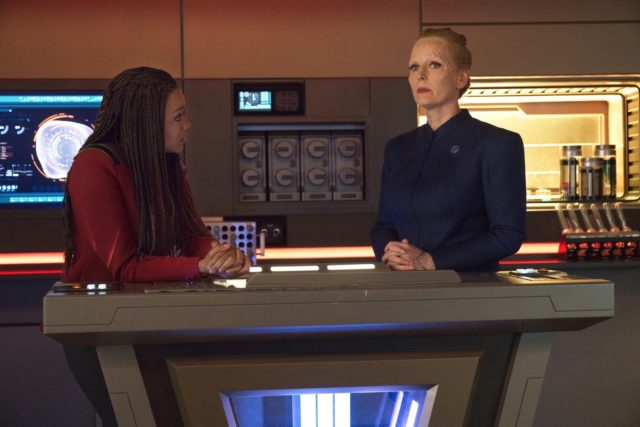
“That’s who you are dealing with ”
After epically screwing up the destroy-the-DMA plan last week, Book is set to dump Tarka off on some random pre-industrial planet, but the wily scientist worms his way back, arguing he can get them through the barrier to take down the DMA from the source. He even knows where they can find a “stash” of that programmable antimatter for the shielding—and that location is a former Emerald Chain work camp. Sure, let’s keep trusting this “a—hole” (hey, he said it). Turns out this was the camp where Tarka was held prisoner and forced by Osyraa to work on a dilithium alternative warp drive, paired up with another alien scientist. Oros is that friend Tarka talked about a few episodes ago, the one he wants to reunite with.
Over a couple of years, Oros and Tarka bonded over math and grew close… apparently very close. They hid programmable antimatter as they secretly worked on an interdimensional transporter that could take them to “Kayalise,” a mythical parallel universe that turns out to be a real “paradise.” But of course, Tarka had a backup plan, betraying his friend to The Chain. When their escape attempt failed, they got separated. Oros forgave Ruon, who has been returning every year to this alien world in hopes of a reunion, convinced his old companion made it to that paradise. And with the power of the DMA, he can too. Now re-shielded and re-bonded, the pair is ready to head out of the galaxy.
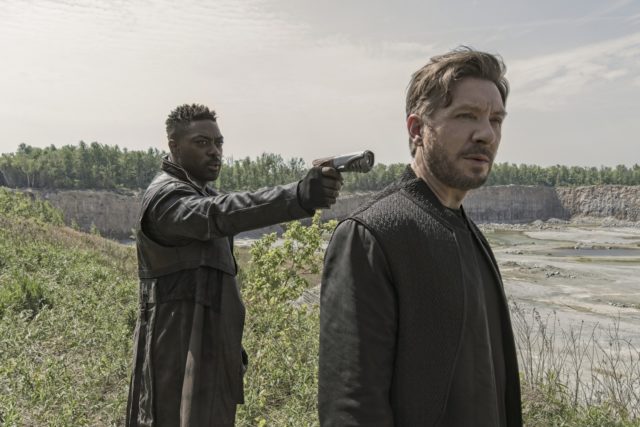

“I cannot envision any situation more awkward”
Even with all the sci-fi action and backstory revelations, the episode found some time for some character catchups. Saru and T’Rina’s budding romance had an awkward moment as the Kelpien got Vulcan-blocked by some aide after trying for his own ominous goodbye, only later to find T’Rina on the mission, as her delegate didn’t make it to HQ in time for departure… oh boy. Good thing he has his new wingman Culber around to advise him that “beginnings can be messy” and it’s all going to work out, just like it did with Paul.
Speaking of Stamets, he is creating his own awkward moments, being the overly proud dad, boasting to the Captain about his returned adopted kid Adira, back from their time away on Trill (with Gray left behind). As Paul beams, Adira is ready to puke from embarrassment in front of the Captain. Later, Stamets admits he lays on the enthusiasm a bit thick as his way to help Adira cope with leaving Gray behind, which turns out is not a biggie. But the cuddly curmudgeon admits his dad wasn’t there for him, so he is going to be “extra” there for them… aww.
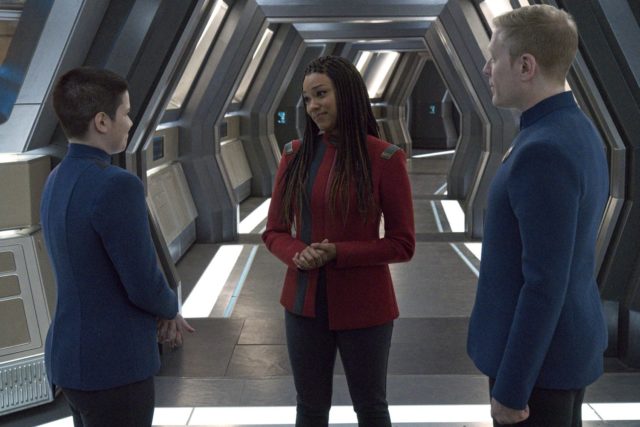
“We have to support each other”
The bubble holdup solution is to find another faster bubble, but getting there isn’t going to be easy on the bridge’s flame throwers and spark generators. As systems fail one by one and shields dwindle, the crew shares some on-the-nose stories about what they want to do when they get back home to Earth, that planet they don’t know is in peril. With some impressive flourishes by the crew and the visual effects team, they make it with a whole six seconds to spare. In another calm in the storm, Captain and POTUFP have yet another mid-mission sidebar in the ready room. Michael argues for the truth, showing how her connection to both threatened worlds only keeps her focused. Rillak reveals her own personal connections to Earth, including the news that her partner is currently on the Moon.
The Disco eventually makes it past the barrier, and with the crew elated to venture where few have tread, the President decides it’s time to tell them the truth. The DMA is days away from the home systems, and she feels their pain. Things wrap up with Saru consoling T’Rina, who really needs his special brand of “comforting presence.” Burnham and Rillak also have a moment, where these two powerful women finally bond in their shared determination and trust. Together they all face the uncertainty that lies before them.
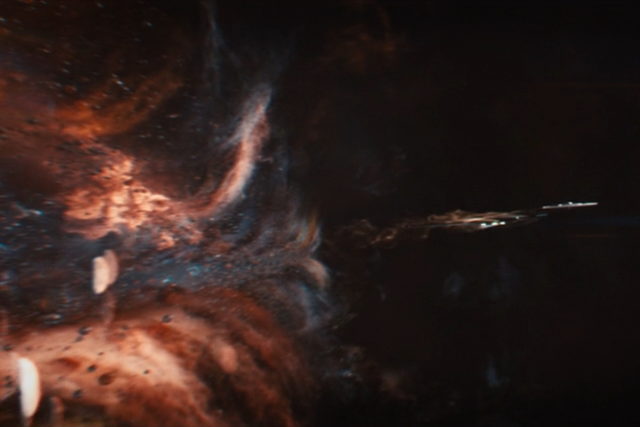
Let’s talk
“The Great Barrier” is another one of those mid-season Discovery episodes where a lot of things are going on, but much of the action is in service of what comes next. After much setup, it appears the show is once again leaving the big reveals to the end, spending much of this episode just getting through that titular barrier. It took the time to set up even more for the final three episodes with intriguing mysteries like Kovich’s more important project, Bryce’s unfinished communication project, and the mention of a new extragalactic planet with potential Species 10-C clues.
While some of this can get frustrating, the episode shined through a focus on the characters, which has always been a strength of writer Anne Cofell Saunders. Perhaps the real “Great Barrier” was the one of communication, which was finally broken through in a number of storylines, like Rillak and Burnham moving past their conflict to shared respect, Saru finally making that connection with T’Rina, and Tarka revealing what truly motivates him. This recurring theme was set up at the start with Kovich’s show-and-tell of the various translator devices, then driven home at the end by the on-the-nose comment by Michael, “If we can’t communicate with each other, what chance do we have with them?”
And Culber talking Saru through his insecurities sends a nice message to all those who ever felt awkward knowing they are not alone, which has always been an important message built into Star Trek. The season theme of uncertainty (mentioned out loud twice during this episode) had some political allegory woven into it this week with Burham’s message about how leaders (like the President) need to show how they are “not rattled by uncertainty or overwhelming odds.” But the mention of confirmation bias (even in a sci-fi context) seemed out of place. All of this is a reminder this season was written early on in the pandemic, which is this season’s muse.
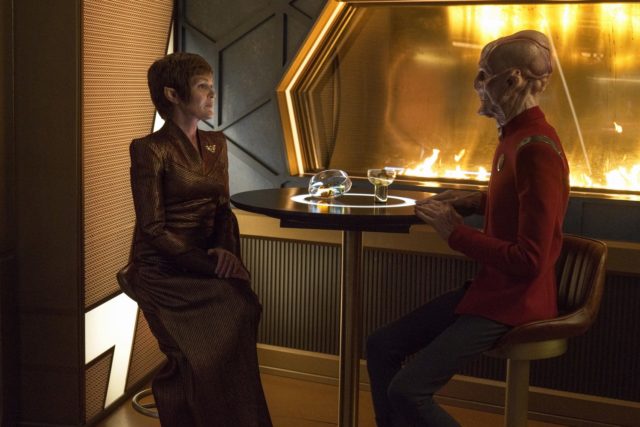
Going home again
“The Galactic Barrier” didn’t do much in terms of worldbuilding, but we did learn a lot more about Tarka, making him a bit more sympathetic. It turns out the “home” he keeps talking about is just another name for Kayalise, the paradise universe where he hopes to find his friend Oros. Even Tarka’s bad people skills were explained; turns out he was held in isolation for years by the Emerald Chain. Reconnecting with Oros, perhaps the only real connection he has ever had, is what drives him. Although why he needs the super-massive power of the DMA is now even less clear as apparently Oros’ transporter was powered through geothermal energy and a warp drive. Perhaps, although Tarka might not admit it, he lacks the same scientific skill as Oros.
We learned the spore drive is limited to work within the galaxy as the mycelial network “thins out” at the edge. This makes the USS Discovery just another ship out there beyond the edge. And this episode did seem to make a big deal out of crossing that line with a number of moments highlighting the risk they were taking and telegraphing that not everyone may be coming back. We get some nice added dimensions to the bridge crew as they share what they will do once they get back home; however, such declarations are often ominous signs. And in this case, the whole segment was a bit hammy coming right after Michael’s talk about the crew’s connection to their home planet.
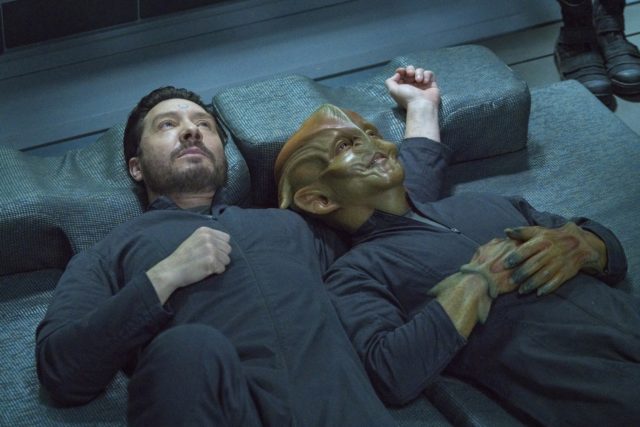
Final thoughts
Strong performances, especially Shawn Doyle (Tarka) and Chelah Horsdal (Rillak), and outstanding visual effects elevate this tenth episode just enough to recommend it. But after four seasons, it’s clear Discovery may work better with their arcs playing out over shorter seasons, and this will actually be the case for season five, which will have ten episodes. “The Great Barrier” will probably play very well as part of a binge-watch; unfortunately, for now, we have to wait to see how the final three episodes of season four play out.
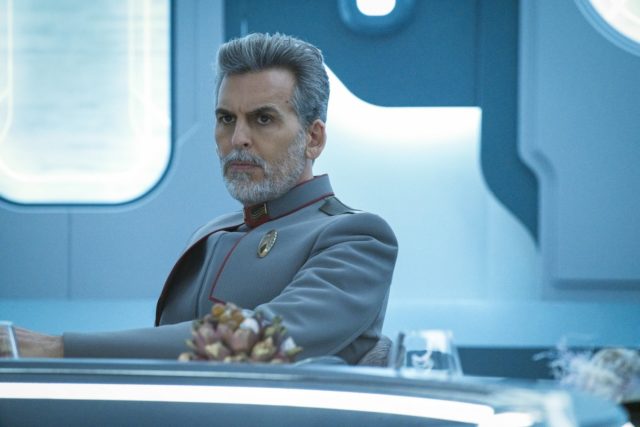
Random bits
- This is the fourth Discovery screenwriting credit for co-executive producer Anne Cofell Saunders, who joined the series in season three.
- This is the first Star Trek credit for director Deborah Kampmeier, who was mostly known for writing, producing, and directing independent films before starting to direct for television in 2019.
- The titular Galactic Barrier was first encountered in the second Star Trek pilot, “ Where No Man Has Gone Before .”
- There is another reference to that episode (and Star Trek’s opening narration ) in Captain Burnam’s speech, saying “When I was a child, I like many of you, dreamed of going where no one has gone before.”
- Vance says that the Discovery is “leaving the galaxy,” adding “we have never done that.” The USS Enterprise did so in “By Any Other Name,” and there have been some other examples of extragalactic travel in Star Trek, however, he may have just been speaking about more recent history with the 32nd century Starfleet.
- Main cast member Blu del Barrio returns as Adira after being absent for two episodes.
- Book said he got the coordinates for the 10-C system from Haz Mazaro , from the episode “All In.”
- President Rillak was an ambassador for 20 years.
- Stamets told Captain Burnham she should “thank Heisenberg” for his plan to use get through the Galactic Barrier, referring to German physicist Werner Heisenberg and science of Quantum Fluctuation derived from Heisenberg’s Uncertainty Principle.
- The golden ratio discussed by Oros and Tarka is the mathematical ratio defined as “the same as the ratio of their sum to the larger of the two quantities.” The Greek letter phi (as seen in the episode) symbolizes the golden ratio.
- Dr. Hirai is a specialist in astrolinguistics , xenophonology , and theoretical semiotics , all of which are real disciplines; however, xenophonology currently is related to “ conlangs ,” or created languages (like Klingon).
- Michael’s mother Gabrielle Burnham is not in danger, as she is still on the monastic world Pijar with J’Vini, who is serving her sentence of rehabilitative meditation.
- The alien planet Book and Tarka visited was shot at The Lafarge Quarry outside of Toronto, which the series has now used multiple times .
- Do traffic jams still exist in the 32nd century (or 23rd)?
- Kovich mentions Vulcans studied humans for “almost a century” before making First Contact, which tracks with the story told in Enterprise’s “Carbon Creek” set in 1957, almost a century before First Contact in 2063.
- Kovich says leaving the galaxy for members of the First Contact Committee will be like a “three-hour tour,” indicating Gilligan’s Island reruns continue into the 32nd century.
- In addition to Ni’Var President T’Rina (Tara Rosling) and Earth General Ndoye (Phumzile Sitole), the Committee delegation included an uncredited Ferengi, with no lines of dialogue.
- A collection of universal translators/communicators featured on Star Trek: The Original Series , The Next Generation , Voyager / Deep Space Nine , Enterprise , and Picard were arrayed on the table for the committee.
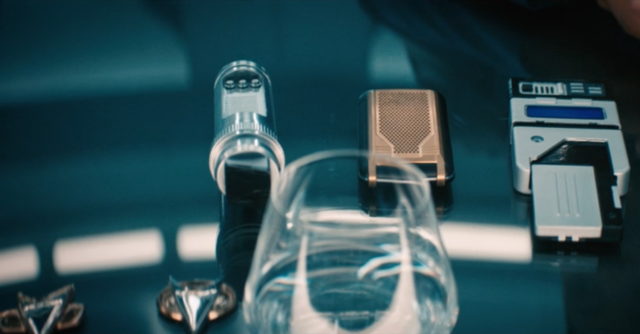
More to come
Every Friday, the TrekMovie.com All Access Star Trek Podcast covers the latest news in the Star Trek Universe and discusses the latest episode. The podcast is available on Apple Podcasts , Spotify , Pocket Casts , Stitcher and is part of the TrekMovie Podcast Network.
New episodes of Star Trek: Discovery premiere on Thursdays on Paramount+ in the U.S. and on Fridays where Paramount+ is available around the world. In Canada, it airs on CTV Sci-Fi Channel on Thursdays, and streams on Crave on Fridays. Starting November 26, Discovery also streams on Pluto TV in select countries in Europe and is available as a digital download in additional international territories .
Keep up with all the news and reviews from the new Star Trek Universe on TV at TrekMovie.com .
Related Articles
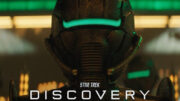
Discovery , Interview
Interview: ‘Star Trek: Discovery’ Writer Carlos Cisco On Unmasking The Breen And Revisiting The ISS Enterprise

All Access Star Trek Podcast , Discovery , Strange New Worlds
Podcast: All Access Gets To Know The Breen In ‘Star Trek: Discovery’ 505, “Mirrors”
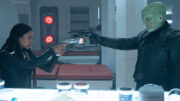
Discovery , Review
Recap/Review: ‘Star Trek: Discovery’ Reflects On Its Choices In “Mirrors”

Books , Discovery
Coffee Table Book On The ‘Star Trek: Discovery’ Makeup Artistry Of Glenn Hetrick Coming In September
With a lot of flash and filler, “The Galactic Barrier” is more of a setup for what comes next than a fulfilling standalone episode.
This describes many episodes of Discovery. Maybe 13 episodes a season is still too many if everything is going to be serialized now?
Addendum: I overlooked that Anthony concluded this also at the end of the review. Season 5 will only have 10 episodes, so maybe that will help streamline out filler episodes like this one.
I still hope they come to their senses and change the formula for S5 and beyond, something in the vein of ENT S4, with mini-arcs of 2- and 3-parters instead of season-long arcs.
That ship has sailed. The streaming convention is one long story, and P+ is not in a situation with their subscriber numbers to start bucking convention.
Except that they’ve indicated that STRANGE NEW WORLDS will not be one long story. They would do very well to have it emulate ENT season 4, which I think is, overall, the best season of Star Trek.
But the barely serialized TNG and Voyager are the most popular legacy Trek shows in streaming.
Agreed. They have maybe 3 episodes worth of plot, and the test is filler character work that could be condensed
I don’t know… I would prefer that format myself. It might improve the show. But I honestly think the ship that has sailed for this show is really the quality ship.
When all is said and done, I’d love to see someone edit the episodes down to the basic plot / storyline into 1 or 2 episodes.
Yep, this has been Discovery all season long. It’s a pretty much 2-3 episode arc drawn out over the entire season. Totally unnecessary. It tells me the writers really have no imagination.
“Kovich says leaving the galaxy for members of the First Contact Committee will be like a “three-hour tour,” indicating Gilligan’s Island reruns continue into the 32nd century.”
Or he’s a time traveler, lol…
Or he’s a time traveler, lol…
I know you’re joking, but you may turn out to be close to the truth. Like I’ve suggested in previous comments, Kovich’s anachronistic and archaic glasses/tie/suit outfit may be a clue that the guy is originally from the 20th or 21st century (or he’s spent a lot of time there).
I expect Kovich to turn out someone we know in a different shape. Maybe someone like Gary Seven, Flint or even a Q.
I found that comment to be a weird analogy. Why would he reference an element of a dead medium from 1200 years earlier that NO ONE would get except a handful in the audience watching this show? Again, I feel like this is writers thinking they are being clever when they are really just being absurd.
Using a reference that nobody will understand seems to be in character for Kovich.
Rather like “only Nixon could go to China” is an ancient Vulcan proverb? I doubt in 300 years anyone will get the analogy. Hell, I wish someone would remember it *today*.
Good call. That was something done purely for the audience. Perhaps it is my bias but I accept it that sort of thing much easier in TUC than I do for Star Trek Discovery. Likely because Star Trek Discovery hasn’t earned it.
Haven’t seen the episode yet, but…..programmable anti-matter??!!??
Why not? In isolation, antimatter behaves just like “normal” matter, so given anti-elements more complex than anti-hydrogen, there’s no conceptual obstacle to anti-mechanisms. We wouldn’t be able to synthesize them, since our only available tools consist of normal matter (and having your fingers go “poof” in a spray of pions and gamma rays is inconvenient), but it’s a reasonable extrapolation that Trek forcefields and replicators — between the 24th and 32nd centuries, presumably — can stack anti-atoms into nanomachinery.
Honestly I sorta feel like the only thing in the show that could make sense is when they come up with some sort of super magic like tech. There just isn’t nearly enough of that to make me, a viewer, believe they are in the 32nd century.
I was pretty disappointed with the re-interpretation of the Barrier in the remastered WNMHGB — how did it come off n this episode?
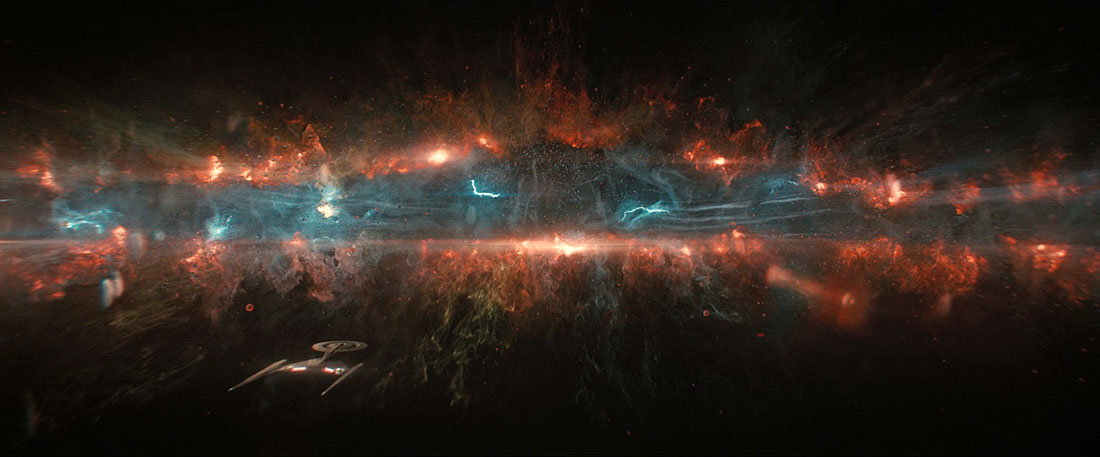
So that’s not conceptual art, that’s an actual final image? (haven’t watched the show since end of s2, had hoped things improved visually at least.)
Oh my, I LOVED the remastered barrier in TOS-R. This one here is a tad off. Still nice but I need my fix of magenta :-)
On the other hand. The issue with that barrier is that it doesn’t really make any sense because it’s some sort of band. Why going through it if you could easily dive below or above? But that was screwed up in 1965…
The original effect to me was reminiscent of an aurora from a distance, and a lethal zone of hellish radiation while the Enterprise was embedded within it. The remaster struck me as just one more generic CG particle cloud, rather like the “badlands” effect in the Voyager pilot.
This new version at least looks more interesting, but I’d have to see it in motion to really judge its effectiveness.
And fwiw I’ve never had an issue with the logic of its appearance — it comes across as a band in those shots because it conforms to the shape of the galaxy, which at its outer edge is a flat disk. Attempt to get around it by leaving the galactic plane of the ecliptic and you’ll just run into more of it.
I am pretty disappointed they continue to use a non-existent feature of the real Milky Way. Sci-fi is supposed to have plausible basis in reality. Even programmable anti-matter seems somewhat more plausible than this.
Well, c’mon now. The galactic barrier has been canon in this franchise since 1965. It’s not great science, but when Isaac Asimov pointed that out at the time Samuel Peebles did a pretty decent job defending the concept in his script as dramatic license, as even Asimov himself acknowledged. If hard-science accuracy is what you’re going for I’d suggest you skip Trek altogether and stick with “The Expanse,” even with the disappointing final season.
Remember that the galactic barrier isn’t detectable to sensors until you get close. I have come to the conclusion that the barrier isn’t visible until you get close to it. That’s why we can see other galaxies, despite there being a barrier all around. It becomes visible in reaction to your matter getting close to it, so there will always be edges to the visible manifestation of it because it is only visible where you are.
I like the explanation from the TNG Q Continuum novels that the barrier was made by the Q Continuum to keep the being 0 out of our galaxy. The fact that it is Q technology partially explains the effect of giving godlike powers to certain sensitive people. I would love if a canon story would simply declare that it is not a natural phenomenon. That would add really cool menace and mystery to it. If it is natural, it makes no sense. Galaxies aren’t isolated bubbles filled with stars.
@ JEffect – those ideas certainly help to explain the idea of ‘our’ galaxy having a ‘galactic barrier’ around it.
It’s not something that troubles my own ‘personal canon’ though, as I prefer to look on the original TOS show’s ‘fantasy’ universe as being just an alternate universe to our own actual universe, even though many elements are similar from our recent world history and other aspects. And the original show’s universe is showing a ‘future’ unlike ours, and just happens to have a ‘galactic barrier’ around it’s particular ‘Milky Way’ galaxy. ;)
I have to say this episode was infuriating to watch. What should’ve been the most interesting episode – they’re travelling on a dangerous mission where the stakes are at their highest into the most unknown region of space; the galactic barrier and beyond – was just another expensive, emotionally manipulative soap opera filled with over-emotional dialogue, scoring and irrelevant nonsense.
Why oh why was there a few minutes dedicated to Saru saying goodbye to that random crew member? I don’t even know his name and literally asked aloud “Who TF is that?” and forgot that he had been in it before. What are we supposed to feel from saying goodbye to someone we don’t even know?
Also giving Tarak, or whatever his name is, a backstory this late in the game, and during all of the high stakes, also felt like an unwanted distraction. And actually let me get this characters “motivation” straight; so his whole thing is that he feels super guilty for ratting out his friend to the syndicate folk, although he wasn’t his friend yet when he did, because he wanted to help him escape, but ultimately he did free him and he thinks that he escaped anyways…. but yet feels bad and THAT’S the motivation behind the character? He wants to find his friend? That does not make any sense and as motives go it’s up there with the Burn as just stupid. In the end he still helped him escape. Yes it was messy, but they were prisoners in a messy situation. He could be dead, he could be alive, who cares, those were the stakes of the situation and you freed him!
Why is the writing so bad?!
And why was the “will we tell the crew/won’t we tell the crew” Michael/president scenes even a thing, let alone drawn out so much? DURING ALL THE CHAOS OF THE GALACTIC BARRIER? Have we not had enough of these two bickering and ultimately being best friends at the end? Why do they keep going in circles with these two? WE GET IT. THEY CAN WORK TOGETHER DESPITE THEIR DIFFERENCES. Jesus.
I actually ended up painting my nails during the latter half of the episode. They turned out really nice, so I guess there was one upside to sitting through this mess.
I agree with everything you said. I also wanted to add that the melodramatic moment with Burnham and the pres at the end of the episode made my audibly roll my eyes. Who the hell writes this soap opera cringe?
Kirk and his crew didn’t have this much trouble with the galactic barrier when the went looking for God’s facsimile. They just had the Klingons, which is still more entertaining then this.
That wasn’t the galactic barrier though, as they were traveling to the center of the galaxy. With that being said, the less of Star Trek V the better.
star trek v is gold next to this mess
That’s because that wasn’t the galactic barrier.
I agree with your comments on that guy’s backstory. At this point, I honestly do not care why he’s doing it. I don’t think it matters one iota. I found his explanation scattered anyway. But admittedly it could be because it was hard to pay attention to his boring monologs and flashbacks.
Also agree with the President/Burnham’s tell-them-or-not stuff. Again, that was a non-issue to me. What the hell difference does it make? I guess in the sense that it should have been the Captain’s call because the Captain would know if it would motivate or distract the crew. But again, it was a bit thing over something very very small.
I actually enjoy the character drama filler like between Burnham and Rillak. I personally find this stuff entertaining.
What I cannot understand is why the writers seem to hang an entire season on flimsy core story ideas. Ruon Tarka’s goal—to get access to a power source that’s beyond anything we’ve ever seen so he can do something that his friend did with stuff cobbled together in prison—feels like it’s taking us to an insulting plot resolution as nonsensical as last season’s explanation for the Burn. I really hope we’re actually going to be surprised by a brilliant plot twist that irons-out the wrinkles in this weak plot. Otherwise, this show has so much promise that could be better explored with classic stand alone episodes rather than taking us on a long ride to nowhere.
I think the send-off was because the Bryce actor, Ronnie Rowe jr., is leaving the show.
So it was probably more out of respect to him that it was included rather than as a story point.
“Why is the writing so bad?!”
Based on my own experience working for a Big Dumb Corporation, it’s probably because CBS management is over-relying on stuff like focus group studies to determine the content of the episodes. My guess is they have a team that tries to predict social media trends, and has an internal list of “values” they need to satisfy with every episode. While these things may not be bad in and of themselves, they are usually counter to good storytelling.
The simple truth is, not everyone is going to like or understand your art. You have to risk people not appreciating what you write, if you want to write anything of significance or impact. You have to risk offending people, even.
If you try to make sure your stuff is consumed by a large portion of the population, you’ll end up writing by committee. Even if ostensibly there is a single writer for a given script, that script gets passed through the hands of a number of chefs, each of whom must have his or her input validated. If one person doesn’t grok something, the assumption is the audience won’t either, so it gets stupified. The “show” part of “show, don’t tell” gets replaced with more “telling,” since that’s less ambiguous. Stuff gets left out, only to be shoehorned back in later. Plot holes are missed, since dealing with them takes time, and it’s assumed they can be patched with more “telling” later on as well. In the end, any good ideas the script originally had is lost under a mountain of clunky exposition and missed opportunities.
It’s a plague that effects a lot of modern media.
@ Chris – very much agree, unfortunately.
That was a boring, empty episode. I feel like nothing happened. A lot of episodes are that way this season.
This will always be the case with series that insist of having a single story arc span across an entire season. There will bound to be a couple ‘filler’ episodes just to pad out (re: drag out) the season.
Frankly, it gets very tiring and my patience with Discovery as a whole is wearing very thin. I used to be one of it’s biggest supporters but now I’m not so sure.
They’d be better off throwing in standalone episodes that don’t greatly affect the arc. DS9 was doing that in seasons 6-7 and Enterprise in seasons 3-4. It worked well, I thought.
Some people have been excusing the haphazard character work on this show as being the result of having shorter seasons and not enough time, but clearly there was room to tighten the overall story and service the characters better and more evenly if 13 episodes feels padded! That’s probably a reason why the ancillary characters are getting more to do, especially as the main cast is so small now, but it’s been clumsy how most have been integrated.
Yep. The character problems are NOT the result of having 13 episodes. Last season they wasted two on Georgeau and the MU. That could have been done in less than one.
I remember people complaining about DS9 doing that, too. They kept whining about episodes like “Take Me Out to the Holosuite” during the war. I’m fine with whatever format a show wants to use to tell its story. I don’t really feel like the pacing is slow, because I actually prefer the character stuff most in any show, so I just eat that up.
Sure, -good- character stuff is lovely. This show has very little of it.
I thought the seasons of the new Trek series were reduced from 24 to 13 episodes to avoid such filler episodes…
There are filler episodes no matter how many shows in a season there are.
I wonder if ‘Kayalise’ could be the Nexus? Or will it turn out to be the opposite of a paradise setting up some sort of multiversal conflict for season 5?
Khaleesi? :-)
I’m calling it now. ‘Kayalise’ is somewhere in that hyper field and it’s not another universe.
What is the point of the back story for Tarak or what ever sob story of the wk that he regales us to endore? This character has no point to this story. Book could have destroyed the mining menace without him. Now we are supposed to feel sorry for him. Puuulllease! Isn’t the galactic barrier where the Kirk and crew meet a facsimile of God?
Isn’t the galactic barrier where the Kirk and crew meet a facsimile of God?
No that one was in center of the galaxy… This one is the energy field that turned Gary Mitchell into a ransom God :-)
Anybody else think the planet Burnham mentions will be the same one Gary Mitchell is on?
Wasn’t he left on Delta Vega? On the UFP side of the barrier?
I want to know why no one on Discovery got turned into a god!
No. The Enterprise never actually got to the other side of the barrier. The planet he was left on was a mining planet called Delta Vega.
Has anybody figured out how many worlds are called Delta Vega? (assuming the D-V seen in trek09 was not located at the edge of the galaxy, as that would have been a pretty huge detour from being between Vulcan and Earth.)
Let’s not question the galactic geography used in the KU features. They played VERY fast and loose with that.
No. The galactic barrier is from three episodes of TOS.
I was laughing by myself this morning. The whisper is true. Is not only Burnham, now many are whispering! :D
It’s terrible.
Some of you folks don’t seem to understand what whispering actually is. Speaking in a low tone of voice is not the same thing as whispering.
Well but Burnham clearly whispers…
This show is so tragically underwritten, there is just nothing here. It’s dull, repetitive, cliche, and cringe inducing melodrama. They don’t have a full cast, and their most important characters have nothing to do. Problems get solved instantly and over-explained to the point of eye-rolling convenience. Their instant understanding and explanation of the bonkers galactic barrier bubbles was just stupefying and nauseating. And this is another episode where I was constantly rewinding the scenes to catch what they said because the exposition was so abrupt with muddy on-set audio. I can’t believe how much I’ve grown to outright hate this show, and I use to love it. This season is the worst because it’s a snoozer and they are constantly farewelling their few remaining crew members. I’m just dumbfounded at what little has actually happened this season, easily the worst so far because it’s boring and meaningless.
And every season they promise the support Cast will have more to do
This season really is spinning its wheels, isn’t it? It’s a solid story, but it’s taking forever to get there. Also, the writers need to do a bit more homework, as their knowledge of extragalactic travel in Star Trek has holes in it. There have been several episodes in which ships have left the Milky Way, including not only TOS’s “By Any Other Name” but also TNG’s “Where No One Has Gone Before.” That’s just off the top of my head. There are probably other examples.
TOS’s “ Is There In Truth No Beauty ” went… somewhere else.
Theory on Kovich! Forgive me if someone has already put this forward, but I think Kovich is an adviser/problem solver to the federation and Starfleet, because he is an android and like Picard a successful human consciousness transfer or an android from the beginning and has been around hundreds of years. This could explain why he doesn’t seem to have any concrete position, knows so much and everyone is deferential to him. Or He could be a Q! 😁
I don’t see it, sorry. :)
There’s one (HEAVILY;) thing on my mind I want to mention. Now that paramount, viacom and cbs merged and moved into a financially HEAVILY stronger situation and the change in industry that streaming numbers became HEAVILY more of importance than physical disc selling numbers and least but not last with the new star trek cherishing ceo of Paramount, the chances of DS9 and VOY remasterings also raised HEAVILY with it!
I think everyone needs to stream the TMP: Director’s Edition when it comes along to sell that appeal.
I thought that the Paramount+ exclusivity of remasters was more likely when all of its competitors still had licenses to stream DS9 and Voyager. Now that they’re making Star Trek an exclusive Paramount+-only offering with just Netflix still carrying DS9 for now, I wonder if they’d consider it a waste of money to remaster the SD shows since they’ve already “got” us.
They got us right. But so I think they don’t want to loose us. Honestly these 90’s video tape quality took away A LOT of enjoyment for me of watching these shows. In 2022 on a 4k screen this quality does not match. Especially for a Sci-fi show playing in the future and with ACTUALLY great looking sets if one could see them as they supposed to be seen clear and shiny.
TNG is still on Netflix.
And I have no intention to stream the TMP director’s edition. I wand a BD. If there is no BD then I will just live with my DVD.
TNG is still on Netflix, but I think it’s the last place with either of the SD shows still.
You missed my point that was not what I meant. I too want to have a 4k blu ray of TMP and the TNG films and they will come out. I also want ds9 & voy on blu ray. But my point is that paramount don’t have to rely on good disc selling numbers anymore to engage the remasterings. It’s streaming now.
OK. I just wanted it out there that I am interested in an HD blu ray. Not 4K. Which is fine but I haven’t upgraded to that. If there is no BD then, as I said, I will just have to be happy with my DVD.
Um…… what?
I loved this episode and the focus on the characters. Especially enjoyed the scenes between Burnham and Rillak.
Honestly, you love anything that Discovery puts out there. You’re not picky. And that’s too bad.
I did not enjoy this episode for several reasons.
- I get it it’s 900 years in the future. Tech is better and can withstand more of a beating. But if Discovery has explosions and fires throughout its bridge in episodes 1, 2, and 3, then the galactic barrier should be visually beating the hell out of the ship. It’s inconsistent and annoying.
- When the ship switches from normal matter bubble to anti-matter bubble can that have some effect on the crew visually? There was barely any consequence. I never had any concern about Discovery being lost in this episode, because they managed to keep their shields the entire time. Crew should be injured. There should be some consequence to this.
- You need two hours to go tell family members goodbye? They all live on the station or the ship. Also, why are you wasting time? The faster you get to the barrier the quicker you can make contact.
- Enough with all of the excessive over-the-top emotionalism. We don’t need to talk about how we feel every 30 seconds. How does anyone get anybody get anything done constantly needing to take a break to cry? Suck it up.
- And the 3-hour tour reference was awful. I guess people in the 32nd century are watching Gilligan’s Island now.
I’m sorry. This episode had such potential to add some real stakes to the situation, with Discovery leaving the barrier going into the unknown injured and weak, trekking forward despite injury and chaos to save the universe. And how do we end this episode? Everything is all good. We’re fine and heading toward a planet.
This is the first time in a season and a half where I have actually been disappointed in a Discovery episode.
Enough with all of the excessive over-the-top emotionalism. We don’t need to talk about how we feel every 30 seconds.
I have to agree. The scenes between Stamets and Adira dragged on endlessly; the Oros-Tarka scenes weren’t much better. This is not exactly taut writing.
Any chance this could be the Kelvins from TOS?
The showrunner has said in interviews it’s something new.
i do not care if it’s something new. not anymore. this whole season winds up the long road to total boredom. sorry.
This episode was the best of a season of horrible episodes, but still a 6 of 10 at most. The most compelling part of the episodes was the background story about Tarka. Sean Doyle was masterful.
As usual, the Burnham character was underwhelming, with her long-winded speeches and whisper lines.
Discovery is horrible – the story arcs with the big bad of the season don’t work well. They could, but the writing is horrible.
I’m so sad for Star Trek. Discovery stinks. Picard season 1 was not good. Lower decks is a stupid childish show.
Agreed on the bottom 3 paragraphs. The only saving grace at the moment is that Prodigy doesn’t suck.
Actually, I like Lower Decks. Of the three shows you mentioned, Lower Decks is the most Trek-like of all of them.
How are we supposed to see other galaxys through this galactic barrier? Why are they having all the communicators on the table… just to make a point?
This was not good!
You could ask the same question the three previous times the Galactic Barrier appeared in TOS. If anything, this version was far less opaque than it was depicted in TOS.
True. I think the concept of the galactic barrier is Not auch a great thing.
There ist Always that “Wall” of Energy. But what is With all the rest? All the Other directions.
You can see other galaxies through the galactic barrier because it isn’t apparently visible or detectable until you get close to it. It becomes visible in reaction to your matter getting close to it. That’s why there are edges to the visible manifestation of it, because it is only visible where you are. This is consistent with the writing in TOS, but is made clearer in the non-canon TNG Q Continuum novels where the barrier was made by the Q Continuum to keep the being 0 out of our galaxy. It would be so much better if they discover this season that the galactic barrier is really alien technology.
I’m really liking the relationship between Rillak and Burnham. The stated theme of the season is uncertainty. That’s what the producers have told us. That’s abundantly clear in the text and subtext of the episodes so far, but I’d say that complementary themes to that one, as seen in the season so far, are themes of transparency and good faith. It’s something that goes back at least as far back as the first season finale, something that Pike certainly demonstrated as captain in season two, and something Burnham finally fully integrated after “Unification III,” having to relearn that lesson several times before that.
The two had a discussion in which they clearly, but respectfully, delineated boundaries. Burnham is in command of the ship, and will not be questioned on the bridge. Rillak must navigate the delicate political situation as she sees fit. By granting Rillak the shipwide address, she allowed Rillak to make the choice to divulge the contents of the update regarding the DMA.
I liked how the Tarka/Oros story was kind of like DSC’s riff on the classic DS9 episode “Hard Time.” Tarka and his friend, Oros were prisoners at a work camp run by the Emerald Chain. As in “Hard Time,” Oros was already there when Tarka was detained. The two gradually bond over science, particularly over the digits of the Golden Ratio. They use their engineering powers to develop an interdimensional transporter. It fails and alerts the guards. As in “Hard Time,” Tarka betrays Oros, this time by having previously told the guards and Osyraa that he would tell them what Oros was working on, in exchange for freedom. As in “Hard Time,” Oros forgives his friend. Though Tarka defeats the guards, Oros is severely injured so he begs Tarka to make a break for it. That was the last Tarka saw of him. He’s returned every year since, hoping for any sign that Oros is even alive, or if he managed to make any progress traveling to an alternate universe. One major difference from “Hard Time,” is that Tarka is the calming influence, rather than the veteran prisoner.
It certainly doesn’t excuse anything that he’s done. It would be fruitful to contrast this with J’Vini from “Choose to Live,” who was intent on saving a species, leading her to kill Starfleet officers to get dilithium. Burnham wanted justice served, despite her and Tilly helping J’Vini save that species. She had to settle for turning her over to Ni’Var. At this point, Burnham only knows that Book and Tarka did not comply with the conditions Book agreed to. Before “All In,” she thought Tarka coerced him. Now, she probably has to assume that Book lied to her. It’s kind of the opposite side of the coin.
First off, I think the conceit behind the ‘Galactic Barrier’ is dumb and we know it’s not based in any kind of modern science… I think it could have been ignored. It’s a minor complaint,,.. but this is the episode I have been waiting to see. Actual plot movement along things that intrigued me and want to know more.. some interesting questions. More of this kind of episode please.
It’s from three TOS episodes, so it’s well established. Ignoring it would have been a big mistake.
I’m agnostic on whether or not it should have been used. But if they did want to go the route of rejecting it, they could have said it dissipated in the centuries since Gary Mitchell.
I wonder if this season’s plot won’t be used as a way of getting rid of the barrier. I agree, it IS dumb, but ignoring it altogether simply isn’t a valid option.
There has been some talk of “filler” episodes from time to time over the last few years when discussing the short seasons vs the longer ones. This episode is the very definition of “filler” episode. The main thing that caught my attention was that the galactic barrier sure has evolved over the last 900 years! Before the Enterprise got through in a few minutes with little more than bumps and bruises and maybe a crew member or two turning into a god. Later Sybok claimed the danger in the barrier was only an illusion. And the ship sailed through with nearly no difficulty. So I see Star Trek Discovery continues the tradition of the Galactic Barrier being what the script needs it to be.
And then there was that awful moment where the bridge crew, in yet another failed attempt to make them seem like they are more than just scenery, there was that useless banter of what they like about Earth. Good GOD this crew picks the oddest times to speak up about things. Nearly every time we have a “bridge crew moment” it results in a face palm reaction.
Anyway, in the end this entire episode felt like a GIANT waste of 50 minutes of show time.
And I am still wondering what species 10B is that they decided to call this completely unknown one 10C.
In “Where No Man Has Gone Before”, the Enterprise didn’t actually make it through the barrier but was thrown back. So we don’t really know how far in they penetrated. In Star Trek V, you’re conflating the galactic barrier at the edge of the milky way with what was in the movie, which was some type of barrier at the center of the milky way. Presumably different phenomena, although admittedly neither one is explained well at all. The Enterprise did, however, make it through the barrier in the episode “By Any Other Name”. No explanation is given, but as a guess maybe the modifications the Kelvins did to the ship to have it go faster also protected the ship and crew from the effects of the barrier.
It finally hit me last week why the tone and style of Discovery ‘s storytelling irks me when I realized that Discovery is what happens when you mix Star Trek with Grey’s Anatomy.
It’s more later seasons Grey’s with rando side characters who you barely know their names, forced emotional scenes where people’s relationships are being torn apart by their devotion to their work, and the main character ends up in a room near tears or whispering thoughtfully with someone almost every other episode . If you just put scenes of Meredith and Michael side-by-side during the fourth act of an episode the dynamic is nearly the same.
I find the entire Book/Tarka subplot really dumb. It’s a storyline that was unneeded, since there’s enough tension that could come from the DMA itself that there was no need to create artificial tension about Michael’s and Book’s love story.
Beyond that, there are a dozen other ways that are more interesting to do this storyline than just two dudes with grief issues potentially screwing up first contact. What if one of the other major powers had objected to the Federation’s plan and sent their own delegation? What if one of the other major powers wanted to go on the offensive against Species 10C? Written intelligently, that could be interesting drama where maybe hey the other side has a point. But what we have is two dudes outmaneuvering Starfleet, making the organization look somewhat incompetent, and I never believe Book and Tarka might have the right idea because their reasons are so personal and petty. They don’t believe in what they’re doing because they think it’s the right course of action. They believe in what they’re doing because of vengeance and wanting to transport to paradise-alt-universe land.
There need to be actual characters to attach to any point of view expressed in the show. There can’t be a show where it’s just delegates debating their points of view. It has to be attached to consequences we see affect specific characters we get to know. For example, Odo spent the first two seasons trying to figure out who his people were. When the producers were developing the Dominion, they decided they had to make the people running the Dominion Odo’s people. That would make Odo’s dream of finding his people a nightmare. It would propel his entire arc for the rest of the series, forcing him to grapple with where his loyalties lay, how he feels about Kira, whether or not he wants to rejoin the Great Link. As the Female Changeling said about returning Odo to the Link being more important than the entire war, the producers felt that Odo’s arc was similarly a higher priority than the minutia of galactic politics.
Star Trek, like literally every other show in existence, is about its characters first and foremost. Literally every other element of the show, no matter the genre, is designed specifically to support that, not the other way around. One of the directives given to potential Star Trek writers has always been: “can this story be written the same way, whether or not it’s science fiction.”
They have 13 episodes over which they can introduce new characters, if necessary, to tell whatever story they want and expand their universe, and have the views of those new characters come up against the beliefs of the ones we already know.
Yes, Deep Space Nine laid a foundation for Odo’s background, but they also introduced new characters (Martok, Weyoun, etc.) and new factions (The Maquis, The Breen, Section 31) to broaden the issues the core characters confronted when they needed it, instead of just trying to contort the situations of galactic importance to depend on the interpersonal relationships of the ones we know. Beyond that, the episodic nature of Star Trek in both the TOS and TNG eras was able to delegate points of view to the guest star of the week while expanding and deepening the characterization of the leads by having the main characters have to confront those differences over 40+ minutes.
When you boil a sweeping galactic threat down to a reason for character moments in Book’s and Michael’s love life that causes multiple whisper-cry moments in dimly lit rooms, it makes the Star Trek universe so small and limited, while cheapening the threat. You end up with the worst of both worlds in a boring relationship story and what could be an interesting threat that takes the backseat to characters acting stupidly.
Are you really comparing Odo’s arc to any of the characters on Disc?
I get what you’re going for by saying there needs to be a direct link to the characters we know for anything to matter, but you’re literally just ignoring the fact that Tarka was introduced just a few episodes ago and given a backstory literally in this episode, all simply to be shoehorned into this recent one storyline they’ve got going on. Same with Relick being introduced at the start of the season. It’s all just to serve this season-long story and we hardly know them outside of this story.
Odo was a character who was fleshed out long before the Dominion story-arc was created and that’s what gave his connection to the that storyline weight, because we already knew who he was and were invested in his journey.
These characters on Disco only exist to serve the storyline. It’s why Grey was dropped after the burn was resolved. They literally had no purpose anymore. And probably why Adira now feels totally irrelevant. It’s storyline/catastrophic galactic circumstance first, character second with Disco and that just does not work because there is zero weight to any of the drama. They’ve literally only really developed Saru, Michael, and Tilly over four seasons – and they’ve dropped Tilly. Yes Culbert and Stamas have also been developed, but they’ve kinda dropped the ball on those two IMO lately. Sorry if my spelling of their names are wrong but I’m not even sure what their names are after four seasons. And that’s the problem.
Anyhow, the original comment from Edward is SPOT ON. I never thought of it before but your comparison to Grey’s Anatomy is so correct. That is exactly what this show is. High melodrama at it’s worst. Maybe if we view Disco through the lens of a high-budget space telenovela it wont be so painful to watch?
Ugh, it’s actually shocking that these “writers” are getting seriously big bucks to spew out such bad writing week in and week out.
I don’t mind serialized seasons. Battlestar Galactica did a superb job with this. I didn’t appreciate how they wrote previous shows where a character would die one week and everyone was fine the next (like when Tasha Yar died). But Discovery needs a better season-long arc. Last year it was the Emerald Chain. This year it’s the DMA. It just goes from bad to worse and it’s too bad because I actually love the ship and the characters.
Beautiful episode! My favorite so far.
It was the best out of what has been a season of snooze-worthy episodes.
This episode stated off quite well, and I see almost everything people here are taking issue with. What really drew me out was the crew shots during the speeches. I really think the apex haa been reached: they should have been listening and working at the same time. They are on a deadline! That would have helped build tension.
I really didn’t like the bubbles, felt like fantastic voyage mixed with a big pharmaceutical ad.
It’s tough tho. The writing here is just odd enough to kill scenes where the writing is good. Culber is a horrible therapist. Is he always talking about himself? It’s like telling a virgin, hey, I got laid, you can too. But are there any good therapists on Star Trek?
I thought that Ezri Dax was quite good, but she didn’t have much time to be a counselor once she got thrust into the Dominion War with everyone else on DS9.
Are Earth and Vulcan (sorry, ne’ver calling it Ni’Var) close enough for a new DMA to be able to threaten both? That seemed off to me.
Or is the idea that it’s on a trajectory that could take it to either one depending on which way it goes?
I don’t believe it’s ever been explicitly stated in canon, but Vulcan’s system is supposed to be the star 40 Eridani A.
This is kinda confirmed in an episode of Enterprise, when Trip goes along with T’Pol when she returns home and states he traveled “16 light-years,” the distance between the Sun and 40 Eridani A.
Yeah, Ni’Var is only 16 lightyears from Earth.
https://en.wikipedia.org/wiki/List_of_nearest_stars_and_brown_dwarfs
Fair enough! Thanks for the clarification.
40 Eridani is first mentioned as the location of Vulcan in James Blish’s adaptation of “Tomorrow is Yesterday.” Not canon, exactly, but Blish often based his adaptations on earlier-draft scripts rather than what eventually aired, so it’s at least a decent possibility that Dorothy Fontana, the queen of all things Vulcan, put that factoid in her script but later dropped it for time.
In any case, that the Enterprise was able to divert to Vulcan without seriously disrupting its scheduled arrival at Altair in “Amok Time” pretty much settles that (by Trek standards) it must be pretty close to Earth.
As a young fan (and young member of the Planetary Society) I sort of remember wondering how much astronomy science went into designing the planets the Enterprise visited. I feel like there were once attempts.
Although there were some points of interest in the episode and it was not as disappointing as last week, I have to rate E10 as a 6 out of 10 at the most. IMO, Tarka’s backstory was not very compelling. It reminded me a little of Soran who was willing to destroy entire star systems in order to reach the nexus. Somehow we are supposed to feel sorry for Tarka and endangering billions is somehow justified because of a single personal loss. That is absolutely ridiculous! Also they could have taken one or two scenes to tell the backstory – instead they dragged it out for the entire show – once again, ridiculous. Finally Book accepts Tarka’s loss as a justifiable reason to fire on the DMA, for the third time… ridiculous. The writers could have filled the time saved with a couple of scenes about the galactic barrier (since it was the title of the episode), first referencing the Kelvin technology that should allow them to safely traverse the barrier. Second, after sensors unexpectedly found the barrier to be larger and more dangerous than anticipated – Burnham could have called for a briefing with the senior staff asking for options, alllowing Stametts and Adira to shine. So far, IMHO two of the last three final episodes for S4 have come up short – let’s hope the season finale can makeup for these last two weeks.
Unfortunately for me I have to say I really didn’t like this episode and easily the worst of the season so far
It just felt too much like filler and nothing happened. What’s sad is when I read the title of the episode I predicted it would just be getting through the barrier…and nothing else. The FX looked cool but all the character stuff just felt too tedious. And no real stakes. It was obvious they were going to get through it just fine. “Stormy Weather” had a similar feel but just did a much better job heightning the tension even if everyone still made it.
The problem is they are just dragging the mystery out to the point of frustration. I said that about last week’s episode but this one really confirmed it. I think the DMA storyline is interesting but it’s just not enough story for an entire season. I thought this season could be the second best fourth season of the franchise for me after Enterprise but instead it’s fallen to the last so far. Not horrible just nearly not as strong as the others.
Praying to Kahless next week they finally reveal Species 10c already.
This show puts so much emphasis on the storyarcs to the point of living or dying on how effectively that arc is drawn out and concludes.
But even trying to look at this through the lens of how this storyline affects the characters first, I am struggling to find any of this compelling.
Captain Foley on Trekyards made a great point discussing this season and that it should’ve been more like Enterprise in season 3 where you had 4-5 different plot lines going within the bigger story. And that included the Xindi themselves which had their own plot line within it so we weren’t just hearing about this elusive species for 90% of the season until we finally met them. Yeah Enterprise had more episodes so it had to think bigger, but even with just 13 episodes this season Discovery feels like it’s really, really lagging.
Stuff like Book’s grief and Tarka trying to get to another universe is OK, but it’s really not compelling enough to hang an entire season on either.
The writing just feels pretty lackluster at this point and they are just filling time than anything until the big reveal.
Let me get this straight: the threat is that the planet Vulcan (aka Ni’Var) will be destroyed by a piece of futuristic mining equipment? What an original concept! We’ve never seen anything like that in Trek before!
You know, now that you put it like that, it kinda rings a bell or two.
Haven’t seen the episode yet… If at least it was a probe… ;-)
OMG! You’re right! LMAO!
So this season has 13 episodes? I keep hearing its 12.
Quite possibly the most drawn-out, tedious season to date… This story/production format is ridiculously boring and overly dramatic. The latest episode could have been shrunk into 30 mins without the exposition. Discovery stands alone amongst Star Trek series in poor storytelling.
CBS Viacom needs to re-think their approach to Trek. Predecessors, particularly TOS, TNG, and VOY, did a good job with bottle episodes — or at least making significant progress within a two-part episode. This seems like a super-drawn out effort. And the numerous scenes where the characters are standing, with painted facial expressions and limited range of acting, no thanks to poor scripting, were so. gdamn. tedious.
I couldn’t finish last season due to this. I’m serious about not watching the finale. Not hyperbole, but saying this as yet another audience member who is neither invested in Discovery, nor going to waste time by re-watching any episodes. (And I am a life-long Trek fan of all series, save this one–and much of Picard.)
Really sad. Even the “Galactic Barrier” was incredibly bad. From the look of it, why not fly above or below it? How did the TOS Enterprise cross the barrier in “By Any Other Name”–but Discovery has a completely different experience? Drama for the sake of drama.
Ironic that this episode aired on the same day that Sally Kellerman (Dr. Elizabeth Dehner) from TOS “Where No Man Has Gone Before” (the first appearance of the galactic barrier) passed away. Rest In Peace.
Hear, hear.
They probably won’t touch the effects of the barrier as it’s too similar to ‘The Force’ – specifically the Sith – even though WNMHGB predates SW by well over a decade.
RIP Sally Kellerman (Dr Dehner, WNMHGB)… An incredibly sad coincidence. She died the very same day another crew crossed the Galactic Barrier she had crossed first back in 1965. Now she has crossed another barrier.
I actually didn’t know she lost her daughter to infamous Club27 in 2016, the same year we lost Anton Yelchin to that club…
I’m ashamed to say it, but this has become the only Trek series I’m not excited to watch every week. It’s almost a chore. And I don’t like that. From a British perspective it feels like the old Helen Mirren Prime Suspect or anything written by Jed Mercurio: all hype, little substance. And boring as heck.
I don’t begrudge the enjoyment of those who like it, but for me there’s not enough tension or stakes. The characters are flat. The setting feels void. It’s leaving me as cold as the Star Wars sequel trilogy.
You can almost feel the writers’ room hitting waypoints. Like we’ve got to get here, and that means it is what it is. It’s written like Season 6-7 of Star Wars: The Clone Wars more than DS9 – there’s our destination to heck with why and how we get there.
I would marathon all of Prime Suspect in a heartbeat before rewatching a single season of Discovery! Actually, once I’m done with Poirot, maybe I will!
What is sad and regretable about S4 of Discovery is that the season started with so much promise and despite a few mis-steps, up until E9, the season was IMO, pretty good. After a terrible E9, I was hoping for a much better E10, but instead the Galactic Barrier came up way short of what it could have been.
For the most part, IMHO Discovery has improved after a disasterous first half of S1 and I really thought in S4, the show had really found its place in the Trek universe, but over these past two episodes, the writers have really let the cast and crew down.
Perhaps what is most sad is that the show which most embodies the principle of IDIC, has been sabatoged by terrible scripts and poorly written characters. Discovery’s final legacy is still to be written, but at this point the biggest positive of the show is that it helped spawn Short Treks, SNW, Picard, Prodigy and the quirky LDs.
My fingers are crossed that the final two episodes of this season will somehow pull S4 out of the fire and make up for these past two episodes.
What’s odd about species 10c and the DMA heading towards earth and vulcan: if that species is fron another galaxy and the DMA is just a mining device: how do they know who the federation, earth and vulcan are? We know nothing about them (except asuming they are a species and from another galaxy) but they know who targeted their device and where earth and vulcan are? And how can that “mining device” NOT be a weapon? Either they are a omnipotent, omniscient species, or they must be known or they have a spy in the federation. Kovich maybe? And we still haven’t heard anything from the BORG nor the klingons. (except that joke about universal translators and klingon language). Or is species 10c related to something we see in PICARD next week?
Who says that the DMA is traveling towards Earth and Ni’var as revenge? Neither Earth nor Ni’var were responsible for the destruction of the DMA. Book is from Kwejian and Tarka is from Risa. The DMA is moving across the galaxy mining Boronite. It’s possible that nobody is actively steering it.
But that’s what I find odd: The DMA reappears and is accidently heading towards earth and Ni’var. The DMA is very big but so is the galaxy too. In that context the crew can’t perceive it as coincidence and sees it as revenge. (Even if Book and Tarka were responsible.) Which leads to the conclusion that the federation must be known outside the galaxy or/and there is a spy.
Screen Rant
Star trek's 4 quadrants & galaxy explained.
Along with the Milky Way Galaxy's quadrants, the Star Trek universe encompasses galactic barriers, further galaxies, and even a mythological core.
Most of the action in Star Trek takes place in the real-world Milky Way Galaxy which is roughly divided into four quadrants, named after the first four letters of the Greek alphabet: Alpha, Beta, Gamma, and Delta. These are the galactic regions that include significant planets like Vulcan, Qo'noS, and of course, Earth. While Gamma and Delta still bear planets with ominous origins, the Alpha and Beta Quadrants are perhaps touched upon the most within the Star Trek mythos. Despite this common division, The Next Generation also referred to a new quadrant known as Morgana. But not much is known about this certain quadrant as it is not mentioned any further.
Even beyond the Quadrants, ardent Star Trek fans can spot the Galactic Barrier and several other celestial objects that are present in other galaxies like the Andromeda Galaxy (yet another real-world phenomenon) that are still yet to be explored more by the franchise's protagonists. While most of these galactic quadrants can be seen as astronomical phenomena rooted in scientific explanation, the mythos can also incorporate near-godly beings like the Sha Ka Ree in regions such as the so-called "Great Barrier." The two Barriers carry within them such heavenly mysteries that deserve explanations of their own.
TOS Invented Star Trek's Best Time Travel
Alpha Quadrant
The Star Trek galaxy explained that the Alpha Quadrant contains more than 60 home worlds, and this includes Captain Kirk's home planet Earth itself (which Trekkers would call Terra or Sol III). Other major planets include the Tellarite native planet Tellar Prime, Trill, which houses both the eponymous humanoid species and the non-humanoid Trill symbionts, and Betazed, which is inhabited by the Betazoids, a humanoid species that boasts warp-capable space vessels. Even though the majority of territories under the Klingon Empire and Romulan Star Empire fall in the Beta Quadrant, the two forces join the United Federation of Planets and the Cardassian Union to constitute the four great powers in the Alpha Quadrant in the late 24th century.
Beta Quadrant
The Star Trek galaxy explained that apart from the Romulans and the different versions of the Klingons , the Beta Quadrant's highlight is Vulcan, the native planet of Spock and other members of the Vulcan species. Multiple Star Trek encyclopedias suggest that Vulcan is located in a Sector of the same name within the Beta Quadrant. The 2002 publication Star Trek Charts also estimates Vulcan's exact position to be somewhere in the 40 Eridani star system that really exists 16.3 light years from Earth's Sun. Much like Spock, the inhabitants of Vulcan can be identified with their raised eyebrows and pointy ears. Mostly devoid of emotions, the Vulcans are known for leading a life on the basis of logic and reasoning.
The Klingon homeworld Qo'noS and the Romulan Empire's native planet Romulus also fall under this galactic quadrant. The former has a chaotic weather system with frequent thunderstorms and a rocky landscape characterized by numerous dormant volcanoes and caves. The native warrior species of Klingon are bound by their martial traditions and value honor in combat. As for Romulus, the planet served as the second home for Romulans ever since they migrated from Vulcan. The biological cousins of the Vulcans, they had to move back to their original homeworld after Romulus' sun exploded in 2387. According to The Next Generation , Risa is also a part of this quadrant. Known as the pleasure planet, Risa is known for its sexually liberated culture.
Gamma Quadrant
The Star Trek galaxy explained that the Gamma quadrant includes several Star Trek planets such as Brax, Yadera, Meridian, and others. As seen in Deep Space Nine , the Quadrant also houses the Dominion, an aggressive ensemble of several alien species commanded by the shape-shifting Changelings (AKA the Founders). Several territories of the quadrant are under the Founders' control even though they have had only two home worlds. The first home world of the Founders was a rogue planet that housed the Founders who were, at that time, escaping prosecution from the "solids" (how they referred to non-shape shifters). By 2372, the Founders shifted to a second home world.
Related: Star Trek - Spock's Entire Prime Universe Timeline, Explained
Delta Quadrant
The Star Trek galaxy explained that Star Trek: First Contact confirms the origin of the Borgs from Delta but doesn't name their home planet. This is the case for many other species of Delta, a quadrant that is relatively unexplored by the United Federation. Only Voyager offers the most details about the planets within the quadrant. Delta is also known as the domain of antagonistic species like the Borgs, the Kazon, and the Vidiians. The cybernetic Borgs are mostly linked through a hive mind known as the Collective. As for the Kazon, they are nomadic in nature which makes it difficult to trace their planet. Vidiians are similarly migratory and sport-scarred faces as a result of the terrible Phage pandemic.
The Galactic Barrier
The Star Trek galaxy explained in the original series what is known as Star Trek 's Galactic Barrier . In the subsequent years, Trekkers have called it by many names ranging from Great Barrier to the Energy Barrier, but there is still much debate and discussion regarding the origin of this energy field that surrounds the Milky Way Galaxy. The origins behind its creation are still hotly debated so it is uncertain whether the Galactic Barrier was created by a natural process or by artificial means. Most of the conventional spaceships that have tried crossing this barrier in the Star Trek universe have often been destroyed with the crew even gaining psychoactive traits while nearing the barrier.
The Andromeda Galaxy
Progressive exploration of the Star Trek galaxy explained that the Milky Way Galaxy is definitely not the final frontier , as several other galaxies lie beyond it, such as the Andromeda Galaxy. This serves as a home for the planet Kelva, the capital of the Kelvan Empire. The Kelvans are highly intelligent shapeshifters. Because of their intellectual superiority, the Kelvans feel that it is their duty to rule over other species. The same galaxy also includes the humanoid species simply known as the Makers, creators of service robots and outposts in both the Andromeda and Milky Way Galaxy. The outposts were a residential necessity given how a supernova had destroyed their homeworld.
The Extragalactic Species
The Star Trek galaxy explained that the spanning areas of planets and species that border Star Trek 's Galactic Barrier from the galaxies beyond the Milky Way are still vague in Star Trek canon. Still, some information has been obtained on a few humanoid and non-humanoid extragalactic species. Species 10-C is a major case in point. A highly-advanced non-humanoid race with members much larger than humans, the species is responsible for creating the heavily destructive Dark Matter Anomaly. With their bodies adapted to float in gas layers, Species 10-C belong to a homeworld near the Galactic Barrier. Other such examples of extragalactic species include the "space amoeba" Nacene, the physically fragile Ornithoid, and immortal races like the Q and the Douwd.
Related: Star Trek Just Created A Second 25th Century Timeline
The Center Of The Galaxy
Star Trek V: The Final Frontier reveals the presence of the mythological planet Sha Ka Ree right at the center of the galaxy that doesn't fall under any quadrant. An equivalent of the concept of heaven, Sha Ka Ree is regarded in Vulcan mythology as the realm of all creation. But owing to humankind's fear of exploring the unknown and the second Galactic Barrier, the exact physical nature remains unexplored and is regarded as a mythical entity. It goes to prove how the mysteries of Star Trek 's chief galaxy don't just go beyond its exterior but its very core too.
Multiple Alternate Realities And Timelines
Not only is there several quadrants, but the Star Trek galaxy explained that there are also several alternate timelines in the franchise's world. In the Paramount+ series Picard , there is an alternate reality that completely rewrites Star Trek's history . The movies, from the original series to the Next Generation, take place in what is known as the Prime Universe. The J.J. Abrams movies take place in what is known as the Kelvin Timeline.
Abrams showed this in his movies by having the Kelvin Timeline Spock meet a Spock from a different timeline. This allowed Star Trek to move on with any story it wanted to tell by explaining the characters are from different timelines with new and fresh histories. There is also a Mirror Universe, an alternate timeline ruled by the fascist Terran Empire instead of the Federation. With so many quadrants, they all likely ended up very different in each timeline, making the Star Trek stories endless.
More: Why TOS Never Got A Series Finale Until Star Trek VI
- Skip to main content
- Keyboard shortcuts for audio player

- LISTEN & FOLLOW
- Apple Podcasts
- Google Podcasts
- Amazon Music
- Amazon Alexa
Your support helps make our show possible and unlocks access to our sponsor-free feed.
In honor of 'Star Trek: Strange New Worlds' Season 2, a tour of the physics

Regina G. Barber

Berly McCoy

Rebecca Ramirez

Season 2 of the critically acclaimed Star Trek: Strange New Worlds premiered June 15 ( streaming on Paramount+ ). So today, Short Wave boldly goes where many, many nerds have gone before and explores the science — specifically the physics — and the science- fiction of Star Trek . Scientist in Residence Regina G. Barber chats with two Trekkie physicists about why they love the franchise. Astrophysicist Erin Macdonald is the science consultant for Star Trek , and Chanda Prescod-Weinstein is a theoretical physicist and author of the book The Disordered Cosmos .
This episode, the trio discusses the feasibility of warp drive, global cooperation and representation and how the transporters that beam crew members from the surface of a planet to the ship might be breaking fundamental laws of physics. They end at the galaxy's edge — and discuss why its portrayal in Star Trek might be problematic, scientifically.
Space is vast – it takes years for real spacecrafts to travel within our solar system! In Star Trek, characters zip around the galaxy in their starship vessels thanks to warp drive, which let spaceships travel faster than the speed of light. But physics puts a speed limit on anything with mass. These objects have to move slightly slower than the speed of light, which itself has a speed limit. So what's the loophole here?
According to Erin, good ol' suspension of disbelief isn't necessary because, "the math checks out." For that reason, it's one of Erin's favorite pieces of sci-fi in the series. Spacetime is the three dimensions we humans are used to living in, plus time. The universe is situated in the four dimensional fabric of spacetime, with heavier objects "pulling" that fabric down more than lighter — or, weightless, in the case of light — objects. So, spacetime itself could be a loophole to this speed limit. Erin says that to bypass the cosmological speed limit of light, you could simply, "build a bubble of space time around your ship, and then that pushes you faster than the speed of light. " This is the various warp speeds . One bubble for warp 1, another bubble around that first bubble for warp 2 and so on.
Of course, Erin and Chanda both point out that using spacetime in this way requires an extraordinary amount of energy — well beyond what humans are capable of at this moment in time.

'Star Trek: Strange New Worlds' season 2 is a classic sci-fi adventure
Transporters.
It would be great to teleport to work, as Star Trek characters do thanks to their transporters. Upside? No traffic. Downside? The fear that once you've been broken down into particles and beamed across the city, you might not be rearranged in the right order.
In order for a transporter to work, users would have to know both where a given particle is and its velocity. Unfortunately, this is not possible due to a well known physics conundrum, the Heisenberg Uncertainty principle . Star Trek plugs this plot hole with something they call a Heisenberg Compensator that is connected to their transporter mechanics. How it works is never explained. All we need to know is that, in the Star Trek universe ... it does!
So, transporters require a little more suspension of disbelief than warp drive — or good-humored humility if you're Chanda. "I don't think transporters will ever be a thing that we can do. But I always say that it's important for me as a scientist to be humble, and so it may be that there is some science beyond the uncertainty principle that we are just not aware of at this point," she quips.
Galactic Barrier
Warp drive can get ships to light speed and faster in the Star Trek world but space is still HUGE. The Milky Way galaxy is 100,000 light years across so, even at Warp 9, it would take the Star Trek crew years to travel the galaxy. It's pretty rare that any starship gets near the edge of our galaxy, but in the 1960s, Star Trek writers had the crew arrive at the " galactic barrier ." According to the show, this barrier doesn't let communication signals through, is dangerous and gives characters " strange energies ."
Chanda says that the impenetrability of signals is what winds her up most about this fake barrier. "But we see other galaxies all the time, and those are signals," she says. "We see radio observations. We see across the electromagnetic spectrum."
These three sci-fi concepts barely scratch the surface of what "science" — and science — Star Trek uses throughout the series . There's so much physics we didn't cover — and so there will be much more science to dissect in the future.
Listen to Short Wave on Spotify , Apple Podcasts and Google Podcasts .
Questions about the "scientific" underpinnings of other pop culture? Email us at [email protected] . We'd love to hear from you!
This episode was produced by Berly McCoy, edited by Rebecca Ramirez and fact checked by Katie Daugert. Josh Newell engineered the audio. Johannes Doerge is our main legal duderino.
- Star Trek: Strange New Worlds
Den of Geek
Star Trek: Discovery Season 4 Episode 10 Review: The Galactic Barrier
The Discovery officially enters extragalactic space, but we're somehow still no closer to finding out anything about the mysterious Unknown Species 10-C.

- Share on Facebook (opens in a new tab)
- Share on Twitter (opens in a new tab)
- Share on Linkedin (opens in a new tab)
- Share on email (opens in a new tab)
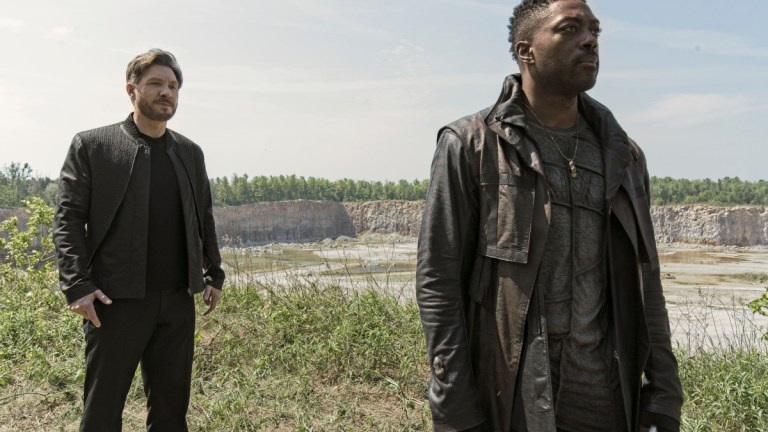
The following contains Star Trek: Discovery spoilers.
Star Trek Discovery Season 4 Episode 10
Star Trek: Discovery goes where few have gone before in “The Galactic Barrier,” taking us out of the Milky Way and into extra-galactic space, a moment of awe that is quietly lovely in a way that little else in the episode is. (How often do we get to see Star Trek show us these kinds of big, humanity-shifting moments? Not enough!) Yet, the hour stops well short of giving us any real answers about the mysterious Uknown Species 10-C or even providing a glimpse of what they or their galaxy might look like. And I can’t be the only person who’s starting to feel like this most recent group of episodes has turned out to be little more than stealth filler to pad the fact they’re not planning to get to the meat of this story until the season’s about to end. [Insert long put upon sign here]
Sure, there have been plenty of great moments in these recent episodes: Sonequa Martin-Green and David Ajala have been selling the heck out of the philosophical and emotional conflict between Burnham and Book, and the show itself has largely been presenting different ideas about how to proceed with the issue of the DMA with a surprising amount of nuance and thoughtfulness. The addition of President Rillak has led to some useful and interesting debates about what the Federation as an institution is supposed to be in a post-Burn world. And apparently, I am willing to sit through literally anything for the slightest chance that Mr. Saru and President T’Rina might exchange weird plants again or have tea for five minutes.
But at this point, if they’re going to keep dragging out this whole Species 10-C reveal, Discovery has got to give us a better secondary story than what we got this week. I mean, apologies if you were among the possible dozen people who were dying to see a sappy Ruon Tarka backstory episode about his time being held prisoner by the Emerald Chain, but I truly cannot fathom why the show thinks we are—or even should be —so invested in this character. And his sappy backstory isn’t even that good!
Ad – content continues below
Perhaps, had the show handled Tarka’s evolution to this point differently and, say, showed us some (or, you know, any) of this guilt and torment he’s supposedly been carrying around for years prior to this moment or possibly indicated that he was capable of emotionally bonding with or caring about another sentient being. Instead, we’ve had multiple episodes of him being a completely selfish jerk who has been completely out for his own ends, and now we’re supposed to feel bad for him because his lone friend has disappeared? Or has possibly built a functional interdimensional transporter to another supposedly heaven-like universe neither of them is even sure exists?
Cry me a river, is what I’m saying. But, of course, empathetic Book finds this all very moving, because he’s been a prisoner of the Emerald Chain himself and the shared memories of torture seem to, if not bond the two men, at least convince him that he shouldn’t kick Tarka off his ship immediately. A move I am sure that Book in no way will come to deeply regret later on.
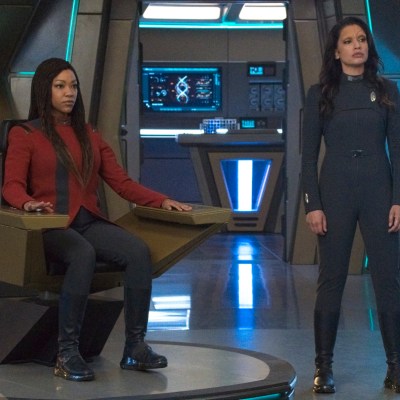
Star Trek: Discovery Season 4 Episode 9 Review: Rubicon

Star Trek: Discovery’s Wilson Cruz Reveals Which TNG Icons Shaped Culber
Meanwhile, over on the Discovery, there’s some fun Stamets Science to save the day, which involves Heisenberg, spatial cells, and negative energy particles, which all somehow manage to allow the ship to travel through the Galactic Barrier and create a cool effect that visually desaturates the screen for a bit. And, naturally, there’s a also new potentially world ending crisis, as the second DMA, the one which replaced the version Tarka destroyed last week , has like twice the power of its predecessor (great job, guys!) and is capable of mining at a much more rapid rate. End result: It’s already moved to a new harvesting site, a whole lot sooner than the week that was initially predicted.
And, of course, it’s now in the Alpha Quadrant, meaning that its deadly gravitational waves will put Earth, Ni’Var, Titan, and most of the major planets our crew calls home at risk of Kweijan-like destruction. Rillak and Burnham’s subsequent fast and furious debate about whether or not to tell the crew the truth about the threat Earth is facing is…well, on paper it’s the kind of discussion I’m glad to know that Star Trek still considers an important thing to highlight its stories, but haven’t we seen these two women have some variation of this same conversation like four times now? No matter how much I love debating how best to balance the philosophical and political realities of the Federation, surely there must be a better way to cover this ground? (Sidebar: I did love Michael’s quiet “you’re my president too” to Rillak. Their entire relationship is simultaneously so weird and strangely interesting. )
Thankfully, as seems to be the norm for the second half of this season, the episode is saved (for me at least) by pretty much everything involving Saru and T’Rina. From Saru’s decision to awkwardly confess his feelings for her just in case he happens to die on this mission to the Galactic Barrier to Hugh Culber’s status as the most adorable wingman in Starfleet, well. Let’s just say this all feels like fanfic written specifically for me. And I want more of it.
Because come on, T’Rina asking Saru (and his “comforting presence”) to sit with her while she mentally and emotionally processes the possibility of Ni’Var’s destruction, that’s practically as good as a date, right? Not traditional, but what about this relationship is? It’s such a sweet moment that I’m not even mad that so many high-ranking political figures are somehow on this first contact mission despite the fact that the odds are decent they’ll all die on it. (Seriously Rillak *and* T’Rina? I know, I know the designated Ni’Var delegate couldn’t make it for whatever reason, but still .)
Maybe next week we’ll finally see the mysterious Species 10-C? Please? At this point, I’m about to give up hope they’re even real.
Get the best of Den of Geek delivered right to your inbox!
3.3 out of 5

Lacy Baugher
Lacy Baugher is a digital producer by day, but a television enthusiast pretty much all the time. Her writing has been featured in Paste Magazine, Collider,…
- The Original Series
- The Animated Series
- The Next Generation
- Deep Space Nine
- Strange New Worlds
- Lower Decks
- Star Trek Movies
- TrekCore on Twitter
- TrekCore on Facebook

The new DMA is immensely more powerful than the original, and after Stamets (Anthony Rapp) calculates that their week of prep time has been shortened to a mere 12 hours, Federation leadership cuts their planning time orders Discovery to the Galactic Barrier as quickly as possible.
The starship jumps through the mycelial network and lands a few light years from the edge of the Milky Way, with a plan to venture through the powerful energy field with newly-installed shielding upgrades to hopefully prevent any Gary Mitchell situations.
The visual effects of the Galactic Barrier were terrific, giving it a much more complex and lifelike appearance than the cloudy pink look seen in previous appearances. And the sequences of Discovery working to make its way through the Galactic Barrier were technically adept.
I was a little disappointed though, that there wasn’t more than a glancing reference to the reason why Discovery’s mission was so dangerous (a blink-and-you’ll-miss-it mention of brain damage)? It was a lot of fun to see the wide variety of old-school Starfleet translation devices during the opening conference scene, but if “The Galactic Barrier” was really going to go all-in on a canon connection… why not spend that energy on making viewers understand why the titular galactic boundary is so difficult to pass through, beyond a little lighting and some occasional desaturation?

While all that extra-galactic stuff is going on, Booker (David Ajala) and Tarka (Shawn Doyle) head back to the site of the scientist’s Emerald Chain captivity to find a secret stash of programmable antimatter left behind at the abandoned research facility.
The exploration of Tarka’s past — and the introduction of his cell mate turned friend-turned-partner, Oros ( Supernatural’s Osric Chau) — was a touching one, with some great performances from both Doyle and Chau. It was nice to get a more rounded exploration of the character beyond being very arrogant, and to see more of his partner’s quest to travel to another universe and what drives Tarka.
The decision to reveal that Tarka does not even know for sure whether his partner even made it to the alternate universe adds even more emotional complexity to the character, and is well received.
But it’s tough to look at the two main plots of this week’s episode without being focused on where it stands in the wider season arc for Discovery — and it’s at that point I can’t help but feel like everything that’s good and great about “The Galactic Barrier” (and the two previous episodes, in my opinion) is being completely undermined by a year-long story arc that too closely mirrors Seasons 2 and 3.

Discovery does not seem to remember how to tell a season-long story outside the structural box it has used for the last three seasons. Another year, another big mystery-box question. Who is the Red Angel? What caused the Burn? Who created the DMA?
There is nothing inherently wrong with basing a whole season’s arc around a single question, and slowly feeding information throughout the season that builds towards a big reveal at the season’s end. Personally, I really enjoyed the third season and the whole arc right through to the end — but at this point, as we go through these motions for yet another year, there’s no drama or surprises left about when the relevant story beats will hit.
It’s been clear for the last five episodes that the reveal of the identity of Species 10-C would be held for the season’s final act, and every passing week feels like the show dragging its feet until the last two or three hours finally get here. Just as the Red Angel and Burn mysteries weren’t answered until the end of each year, Discovery ’s writers seem to think we’ll lose interest in the story if they answer the Big Question too early.
We know the structure, and we know we have to wait until the end of the season — so why does any of this really matter? I mean, it should matter! It’s exciting to see Discovery pass through the Galactic Barrier, and it’s touching to learn about Tarka’s backstory, but this season also feels like it’s reverse-engineered out of a “How do we fill time until it’s finally time to make the big reveal?”
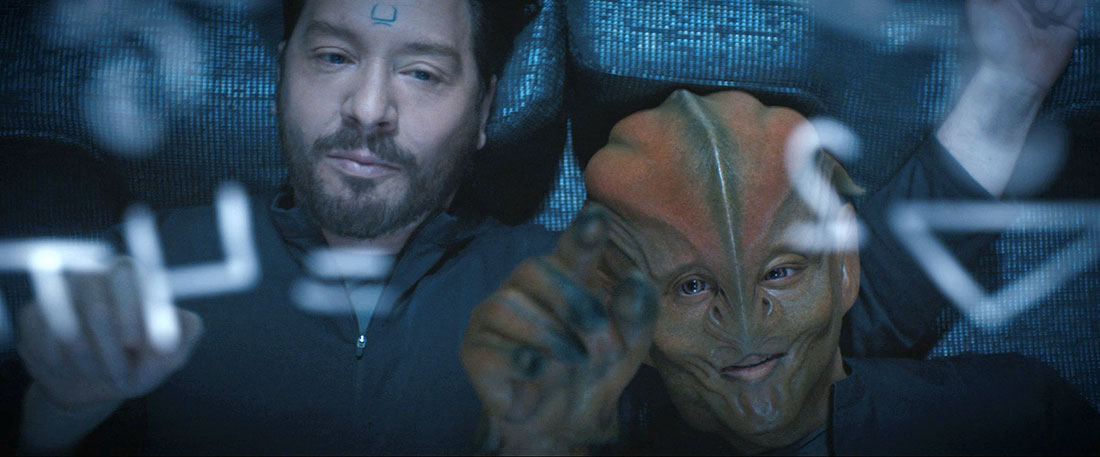
But with this looming DMA story, even the ratcheting up of the stakes at the end and the reveal that Earth, Titan and Ni’Var are now threatened feels pretty rote at this point. For all its flaws and foibles, Discovery ’s first season at least gave us its most novel structure yet, with two distinct but interweaving narratives playing out through the season: the Klingon War and the Mirror Universe.
But for three years now, this show’s structure has been the same. Sure, the question changes and the way the characters reach the answer is different, but the fact that there is a question and that the answer will be revealed in the season’s final act is a forgone conclusion.
I want to care about this show’s characters and events solely for the purpose of caring about the characters and events, and not because they form more obligatory pieces to a puzzle Discovery wants us to put together each season, and then take apart, and then rebuild the next season. I’ve built this puzzle before, and I’m ready for something new.
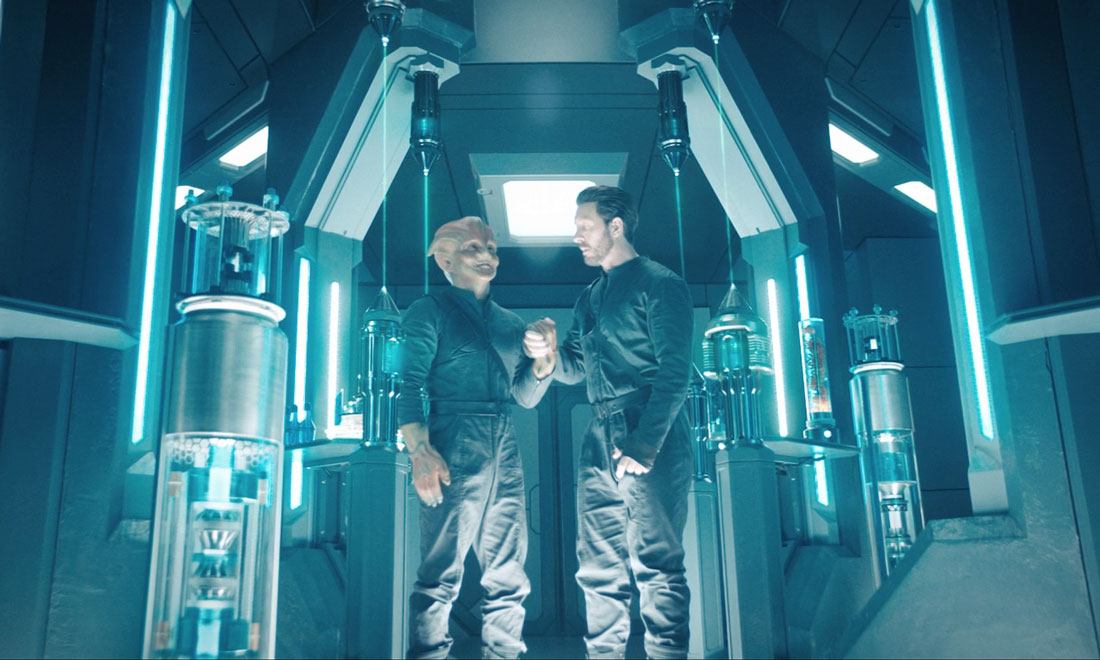
At this stage – more acutely than I think for even Seasons 2 and 3 where this structurally felt more novel for Star Trek – the success or failure of Season 4 is entirely riding on its ending. As stated, I really enjoyed Season 3, and I also enjoyed how they subverted the expectation that the cause of The Burn was going to be something huge — and instead told an intimate tale of loss and grief. But having just done that, the only way not to avoid completely rehashing Season 3 in both tone and structure is to go big.
Showrunner Michelle Paradise has said that Species 10-C is something entirely new to Star Trek . I hope they are as impressively weird and alien as they have been teased throughout this whole season, because the entire story arc is riding on it. If the ending pays off, the journey along the way feels less tiresome. If it does not, then much of this season will feel lifeless.
That’s a sad thing to say about Discovery , which has had so many groundbreaking and exciting moments as it shepherded this new era of Star Trek back to TV. But with some of the newer shows forging more interesting ground and playing with different formulas, Discovery is at risk of losing its place in the conversation – especially since it will need to compete with the opening weeks of Star Trek: Picard Season 2 going forward.
OBSERVATION LOUNGE
- Dr. Kovich (David Cronenberg) notes that Vulcans observed Earth for “nearly a century before First Contact,” referring to survey missions like the one seen in “Carbon Creek.”
- Kovich implies that he’s managing something that’s an even bigger threat to the Federation than the DMA, but won’t share with the council. A hint towards Season 5’s story, or just more oh-isn’t-Kovich-mysterious business?
- Adira (Blu del Barrio) returns for the first time since December, after traveling to Trill with Gray in “But to Connect.”
- Saru (Doug Jones) confesses his “more than friends” feelings to President T’Rina (Tara Rosling)… just before she’s called away on urgent business, an awkward moment only compounded by her sudden reappearance aboard Discovery during the mission. Despite the Vulcan’s emotionally-suppressed worry about her homeworld, hopefully these two crazy kids will get this thing sorted out by the finale!
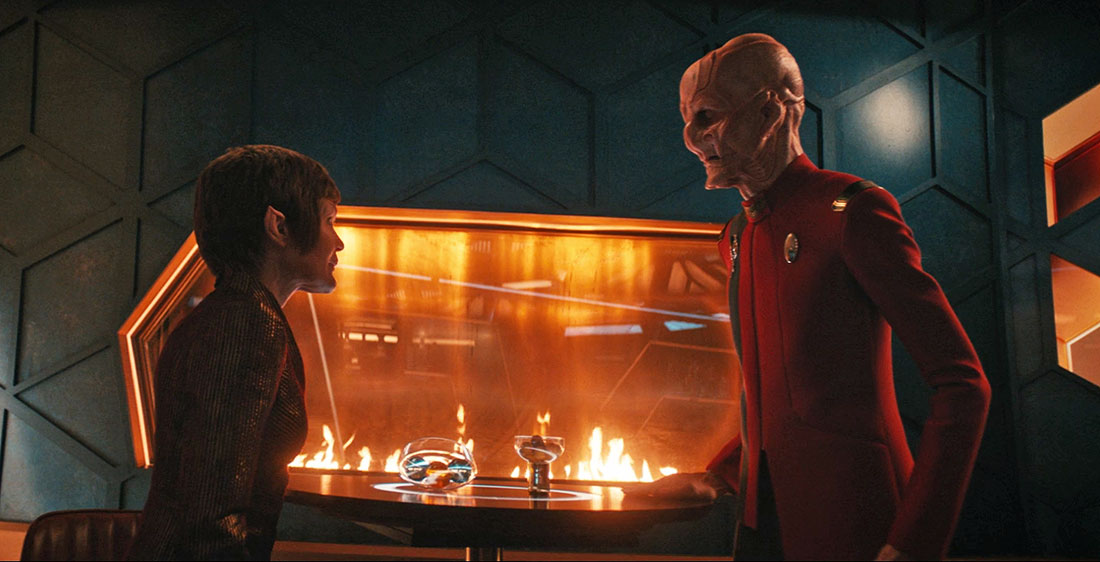
- Captain Burnham (Sonequa Martin-Green) and President Rillak (Chelah Horsdal) work together which much less friction this mission, though the pair do debate whether or not to share that Earth, Titan, and Ni’Var are in the new DMA’s path of destruction. With such a big decision — to keep the truth from the Discovery crew, or to rock everyone with the disastrous news during a critical moment in the mission — wouldn’t it have been prudent to bring ship’s counselor Dr. Culber (Wilson Cruz) into the conversation?
- The mycelial network was described as “veins and muscles that hold our galaxies together” in Season 1, said to span the entire universe and all multiverses as well — but apparently there’s no reception near the Galactic Barrier.
- It certainly seems like this episode may mark the last time we’ll Lt. Commander Bryce (Ronnie Rowe, Jr.), as Saru spends a few moments wishing the officer well as he transfers to Kovich’s service at Starfleet Command. Rowe joined the new BET+ series The Porter in 2021, leading to the actor’s minimal screen time in Season 4.
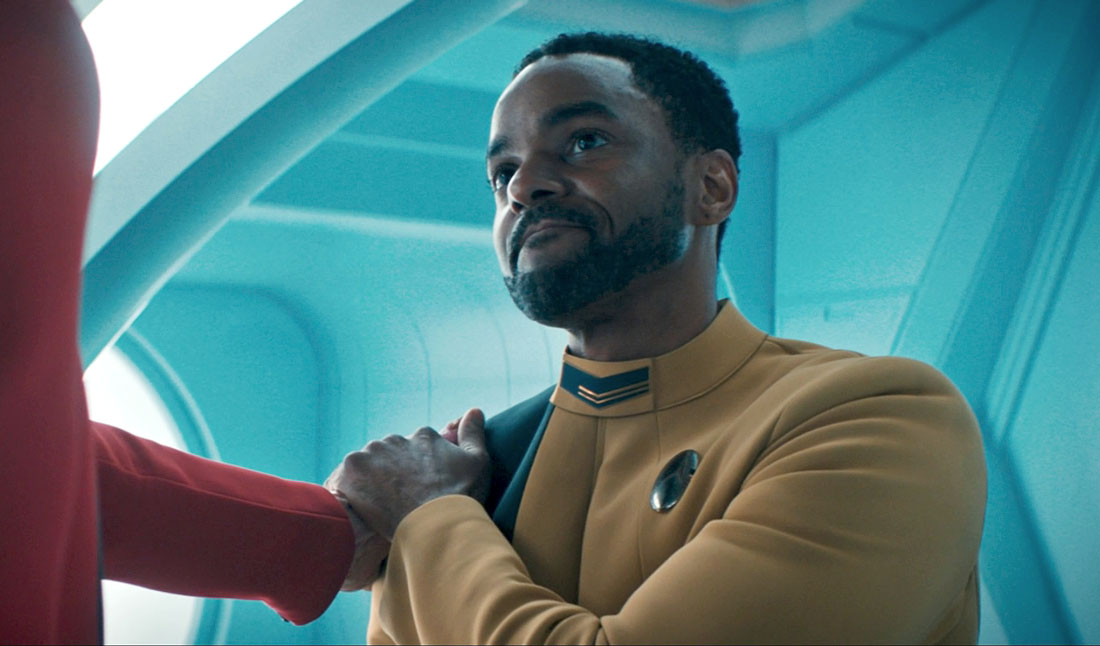
- Classic Star Trek communication technology seen during the mission briefing include both Enterprise -era universal translators ( plug-and-play and wearable types ), an Original Series-era hand-held translator , and Next Generation -era , Voyager -era , and Picard -era Starfleet combadges. Also seen on the table is a flip-open communicator which resembles the classic Trek device, but with a more modern design: perhaps a new communicator we’ll see aboard the Enterprise in Star Trek: Strange New Worlds this May?

There was a lot to like about “The Galactic Barrier.” But I can’t shake how bored I feel with the overall season long arc, and how Discovery has chosen to structure this narrative. It is doing a huge disservice to the great performances, dazzling effects, and engaging relationships that this show should embrace more just for the sake of it.
As Discovery begins to spin up writing and production on its recently-announced, ten-episode fifth season, I hope they look very seriously at mixing up the show’s narrative structure — with three fewer episodes to drag its feet, it’s time for a new approach.
Star Trek: Discovery returns March 2 on Paramount+ in the United States, and on CTV Sci Fi Channel and Crave in Canada. Outside of North America, the series is available on Paramount+ and on Pluto TV in select international locations.
- DSC Season 4
- Star Trek: Discovery
- The Galactic Barrier
Related Stories
Star trek: discovery review — “mirrors”, new star trek: discovery photos — “mirrors”, interview — sonequa martin-green on burnham’s “face the strange” encounter, search news archives, new & upcoming releases, featured stories, lost-for-decades original star trek uss enterprise model returned to roddenberry family, star trek: lower decks cancelled; strange new worlds renewed for season 4, our star trek: discovery season 5 spoiler-free review.
TrekCore.com is not endorsed, sponsored or affiliated with Paramount, CBS Studios, or the Star Trek franchise. All Star Trek images, trademarks and logos are owned by CBS Studios Inc. and/or Paramount. All original TrekCore.com content and the WeeklyTrek podcast (c) 2024 Trapezoid Media, LLC. · Terms & Conditions
- More to Explore
- Series & Movies
Episode Preview | Star Trek: Discovery - The Galactic Barrier
Next time on Star Trek: Discovery...
Spoilers for season four of Star Trek: Discovery to follow!
Check out this sneak peek of season four, episode ten of Star Trek: Discovery .
Star Trek: Discovery currently streams exclusively on Paramount+ in the U.S. Internationally, the series is available on Paramount+ in Australia, Latin America and the Nordics, and on Pluto TV in Austria, France, Germany, Italy, Spain, Switzerland and the United Kingdom on the Pluto TV Sci-Fi channel. In Canada, it airs on Bell Media’s CTV Sci-Fi Channel and streams on Crave. Star Trek: Discovery is distributed by ViacomCBS Global Distribution Group.

IMAGES
VIDEO
COMMENTS
Star Trek. The galactic barrier was an energy field composed of negative energy surrounding the rim of the Milky Way Galaxy. Invisible to both the naked eye and visual recording equipment at a distance, at close range the barrier shone with a purple- to pink-colored glow. No form of transmission was known...
Star Trek: Picard season 1's synthetic villains, who were deathly feared by the Romulan Zhat Vash, originated from another galaxy beyond the Galactic Barrier. Briefly glimpsed in Star Trek: Picard season 1's finale, the synthetic beings have tentacled arms and they intended to wipe out all organic life in the galaxy.However, the synthetic villains used a wormhole to enter the Alpha Quadrant ...
In the Q-Continuum novels, the Galactic Barrier is revealed to be a creation of the Continuum used to keep a being known as "0" out of town, and the psionic qualities of a Q sentry contained therein are, therefore, what causes a fuss to the Gary Mitchells of the world. Reg Barclay is able to use the Enterprise E's bio-neural gel packs to tap into this essence at some point, which sounds ...
The Galactic Barrier in Star Trek is a negative energy field at the edge of the Milky Way Galaxy that disrupts starships and human bodies. Captain Kirk encountered the Galactic Barrier multiple times in Star Trek: The Original Series but never crossed to the other side. The starships of Star Trek set out to explore the farthest reaches of the ...
The Galactic Barrier: Directed by Deborah Kampmeier. With Sonequa Martin-Green, Doug Jones, Anthony Rapp, Wilson Cruz. Captain Burnham and her crew must go where few have gone before: beyond the Galactic Barrier. Meanwhile, Book learns the truth of what drives Ruon Tarka.
In Star Trek, there exists a formidable force known as the galactic barrier, which surrounds the outer reaches of the Milky Way Galaxy. This phenomenon was first revealed in the second pilot ...
Sci-fi. Star Trek. The galactic barrier is an energy field that surrounds the Milky Way Galaxy, delineating the border between the galactic material and the intergalactic void. The barrier appears as a purple/pink band of energy, and has been encountered several times by Earth and Starfleet vessels.
Back at the Galactic Barrier, Discovery -A emerges into extragalactic space. Although they disagreed about informing the crew of the danger to Ni'Var and Earth, Burnham entrusts Rillak with deciding the value of sharing the report. Rillak follows the captain's advice, emphasizing that the fate of those planets may very well be in their hands.
"The Galactic Barrier" Star Trek: Discovery Season 4, Episode 10 - Debuted Thursday, February 24, 2022 Written by Anne Cofell Saunders Directed by Deborah Kampmeier. SPOILER-FREE REVIEW ...
The Star Trek galaxy explained that the spanning areas of planets and species that border Star Trek's Galactic Barrier from the galaxies beyond the Milky Way are still vague in Star Trek canon. Still, some information has been obtained on a few humanoid and non-humanoid extragalactic species. Species 10-C is a major case in point.
Season 2 of the critically acclaimed Star Trek: Strange New Worlds premiered June 15 (streaming on Paramount+). ... Galactic Barrier. Warp drive can get ships to light speed and faster in the Star ...
Galactic Barrier. In Star Trek, the galactic barrier is an energy field composed of negative energy surrounding the rim of the Milky Way Galaxy. It appears as a purple/pink band of energy. No form of transmission can penetrate the barrier. (TOS: "By Any Other Name") Warp travel through the barrier causes extreme sensory distortions.
Star Trek: Discovery goes where few have gone before in "The Galactic Barrier," taking us out of the Milky Way and into extra-galactic space, a moment of awe that is quietly lovely in a way ...
#startrek #science #lore The galactic barrier is one of the most bizarre phenomena in the Star Trek universe. Made up of negative energy, it's clear the barr...
The Barriers are two linked phenomena that mark the inner and outer limits of the milky way galaxy in the Star Trek mythos.The Galactic Barrier is a turbulen...
The Galactic Barrier has been present since the franchise's beginning. Spoilers for Star Trek: Discovery season four, episode ten to follow! Burnham and her crew venture beyond the known galaxy in a moment that's been built towards since The Original Series. Star Trek: Discovery currently streams exclusively on Paramount+ in the U.S ...
In "The Galactic Barrier," Star Trek: Discovery serves up the third episode in a row where great character work and exciting action sequences are entirely undermined by the plodding and conventional structure to this season's overarching story.Episodes should not feel like they are marking time on the way to a grand finale, but "The Galactic Barrier" feels exactly that way — and it ...
Spoilers for Star Trek: Discovery season four, episode ten to follow! Burnham leads her crew through the Galactic Barrier. Star Trek: Discovery currently streams exclusively on Paramount+ in the U.S. Internationally, the series is available on Paramount+ in Australia, Latin America and the Nordics, and on Pluto TV in Austria, France, Germany ...
Your first look at the upcoming episode. Star Trek: Discovery Seasons 1 through 4 are currently streaming exclusively on Paramount+ in the U.S., the U.K., Switzerland, South Korea, Latin America, Germany, France, Italy, Australia and Austria. Seasons 2 and 3 are also available on the Pluto TV "Star Trek" channel in Switzerland, Germany and ...
Spoilers for season four of Star Trek: Discovery to follow! Check out this sneak peek of season four, episode ten of Star Trek: Discovery. Star Trek: Discovery currently streams exclusively on Paramount+ in the U.S. Internationally, the series is available on Paramount+ in Australia, Latin America and the Nordics, and on Pluto TV in Austria ...